How to write a process essay
- August 25, 2023
Process essays are one of the most common types of essays . It’s simply explaining a process of how to do something.
In this article, we’ll show you how to write a process essay in steps with interactive examples.
Process essay definition
Let’s take a look at the steps outlined below to write a clear and effective process essay.

Choose a topic
You should start by choosing a topic that not only interests you but also attracts your target audience.
Whether it’s brewing the perfect cup of coffee or conquering the art of origami, your topic should be engaging and well-defined. Let’s have a look at topic examples:
- Crafting Exquisite Miniature Bookbindings
- Building a Sustainable Vertical Garden
- Making the Perfect Cup of Coffee
So for this guide, I’ve chosen “Making the Perfect Cup of Coffee”. Now let’s continue with the next steps.
Create a process essay outline
Now that you’ve your topic at hand, it’s time to create an outline to present the steps chronologically. Outline will also help you organize your thoughts and ideas so you won’t get lost during the writing process.
Let’s examine this step with an example of a process essay explaining “Making the Perfect Cup of Coffee”.
Process essay outline example
- Thesis statement
- Provide safety precautions if necessary.
- Address to the reader
- Provide any variations or customization options if applicable.
- End with a memorable concluding thought or call to action.
By presenting the steps in chronological order, your readers can follow the process smoothly.
During this step, just make sure to:
- Expand on each step you outlined earlier.
- Use clear and concise language.
- Make use of bullet points or numbered lists to make the process visually appealing.
After completing the outline, it’s time to write an interesting introduction.
Write an introduction
- Hook the reader's interest with a hook sentence
- Offer a brief overview of the topic and its significance
- Introduce and explain the process with a thesis statement at the end of introduction
Process essay introduction example
Introduction
Now that we have an intro on our hand, you need to tell what materials you need to finish the process.
Write the materials needed for the process
Listing the necessary materials for the process is a best practice for process essays. Typically found just after the introduction, this paragraph is devoted to outlining the necessary materials.
Here, p rioritizing the list is important; the more influential a component is, the higher its position on the list should be.
Example material list for process essay
Body paragraphs
Materials needed
- High-quality coffee beans that align with your flavor preference.
- A grinder for optimal flavor extraction.
- Equipment for brewing methods, such as a pour-over apparatus, a drip coffee maker, a French press, or an espresso machine.
- Fresh and clean water for brewing.
- Optional additives like milk, cream, sugar, flavored syrups, or other preferred elements.
Start writing the process
Right after listing the materials needed, it’s time to start writing the process itself.
When describing your process, be careful not to make it too complicated. To keep your readers on track, use transitional words like “after,” “eventually,” “first,” “then,” and others help you maintain an understandable tone.
Or simply use a 1,2,3, bullet point structure as seen in example below to remind readers of their step during the process.
Body paragraphs - Process writing example
Materials needed ...
- Grind the beans just before brewing for optimal freshness. Use a burr grinder and adjust the coarseness to match your brewing method (coarse for French press, fine for espresso).
- Weigh your coffee grounds using a scale. A standard ratio is 1 to 2 tablespoons of coffee per 6 ounces of water, but adjust to your taste.
- Ensure the water is heated to the ideal temperature, typically between 195-205°F (90-96°C). Water that's too hot or too cold can affect the taste.
- Pay attention to the brewing time. Generally, 4-5 minutes is suitable for most methods, but again, adjust based on your preference.
- After finishing, regularly clean your coffee maker or French press to prevent rancid oils and residue from affecting your coffee's taste.
As seen from the example above, using an imperative language structure is generally preferable. It makes total sense as you’re describing a process in steps and usually don’t need a full sentence structure.
Give tips and supporting details
After explaining the process above, it’s now time to provide tips and supporting details. Here, make use examples, tips, and even warnings if necessary.
In other words, anticipate the questions your readers might have and address them as you go along.
Body paragraphs - Supporting details
Supporting details & tips
- Ensure safe handling of hot water and coffee-making equipment.
- Water that's too hot can result in over-extraction, while water that's too cold won't extract enough flavor.
Write a conclusion
At this step, you simply need to write a conclusion paragraph to end your process essay. First summarize the key points, and restate the process in a concise and short sentence. And finally, finish your process essay by a memorable sentence or a call-to-action.
Process essay conclusion example
Revise and polish your essay.
Now that you’ve written your essay, take a breath, and then come back for some editing. Check for consistency, correct sentence structure, efficient transitions , tense selection , and other linguistic issues that may arise.
If possible, make use of proofreading tools like QuillBot or Grammarly .
- Think about potential reader misunderstandings and address them. If needed, explain what should be avoided.
- Offer explanations for steps that might seem unusual or complicated.
- Define any unfamiliar terms or materials that the reader might not understand. This ensures clarity in your essay.
So you’ve successfully learned how to write a captivating process essay. Remember, practice makes perfect. The more you write, the better you’ll become.
Recently on Tamara Blog
How to write a discussion essay (with steps & examples), writing a great poetry essay (steps & examples), how to write a process essay (steps & examples), writing a common app essay (steps & examples), how to write a synthesis essay (steps & examples), how to write a horror story.
5 Process Essay Examples
A process essay is a type of essay that explains a process in detail. Good process essays don’t just explain the process but provides details about common mistakes to avoid as well as tips and methods to achieve success. Below are some example essays:
Process Essay Examples
#1 how to bake a chocolate cake.
1337 Words | 4 Pages

Thesis Statement: “The purpose of this essay is to guide readers through the enjoyable and straightforward process of baking a chocolate cake, highlighting the essential steps and tips to ensure a delicious and successful outcome.”
#2 How to Write a Resume

Thesis Statement: “This essay aims to provide a comprehensive guide on crafting an effective resume, detailing each step from gathering relevant information to finalizing the document, while offering practical tips and common pitfalls to avoid, ensuring a polished and professional presentation of one’s career achievements and qualifications.”
#3 How to Train for a Marathon
1508 Words | 5 Pages

Thesis Statement: “This essay provides a comprehensive guide to marathon training, detailing a strategic approach to building endurance, strength, and speed, coupled with essential advice on nutrition, hydration, and mental preparation, to equip runners of all levels with the knowledge and tools necessary for successfully completing a marathon.”
#4 How to Prepare for a Job Interview
1309 Words | 5 Pages

Thesis Statement: “This essay outlines a comprehensive strategy for job interview preparation, encompassing in-depth company research, personalized response formulation, professional presentation, and logistical planning, to equip candidates with the tools necessary for making a compelling and confident impression in their pursuit of career opportunities.”
#5 How to Write an Essay
1473 Words | 5 Pages

Thesis Statement: “This essay outlines a comprehensive, step-by-step approach to essay writing, from understanding the prompt to the final stages of revision and editing, providing essential tips and strategies to enhance writing skills and ensure the creation of a well-structured, persuasive, and effectively communicated piece.”
How to Write a Process Essay
The following template provides an overview of a process essay structure:

Grab this process essay template here.
Instructions: To write a process essay, start by introducing the process and its significance, ensuring the reader understands the purpose and value of the instructions. Next, present the preparation and materials required, before outlining each step of the process in a logical order, offering detailed explanations, tips, and potential pitfalls to avoid, ensuring clarity and ease of understanding. Conclude by summarizing the main steps and reinforcing the benefits or results of completing the process, leaving the reader with a clear understanding and the confidence to undertake the task.
How to Write a Thesis Statement for a Process
To write a thesis statement for a process essay, identify the process you’re explaining and clearly state the purpose or goal of the essay. Concisely outline the primary steps or stages involved in the process, ensuring clarity and direction for the reader. The thesis should be informative, indicating what the reader can expect to learn and achieve by following the essay.
💡 AI Prompt For Writing a Process Essay Thesis Statement “Create a thesis statement for a process essay on [TOPIC] that clearly identifies the specific process being explained. The thesis should state the purpose of the essay and briefly outline the main steps or stages involved in the process. Ensure that the statement is concise, informative, and guides the reader on what they will learn and achieve by reading the essay.”
Read Also: 101 Thesis Statement Examples
Suggested Process Essay Topics
For Grades 4 to 8:
- How to Organize a School Backpack.
- Steps to Create a Simple Science Fair Project.
- The Process of Planting and Caring for a Vegetable Garden.
- How to Write a Book Report.
- Making a Handcrafted Greeting Card.
For Grades 9 to 12:
- How to Prepare for the SATs.
- Steps for Conducting a Basic Scientific Experiment.
- Crafting an Effective Persuasive Essay.
- Planning and Executing a Community Service Project.
- The Process of Creating a Personal Budget.
For University/College:
- How to Conduct a Literature Review for a Research Paper.
- Writing a Successful College Application Essay.
- The Process of Developing a Mobile App.
- How to Create a Comprehensive Marketing Plan.
- Steps for Conducting a Qualitative Research Study.
- Preparing and Delivering an Effective Oral Presentation.
- The Process of Writing a Business Plan.
- How to Analyze a Case Study in Business School.
- Crafting a Dissertation or Thesis Proposal.
- Developing and Implementing a Personal Fitness Plan.
Ready to Write your Essay?

Take action! Choose one of the following options to start writing your essay now:

Chris Drew (PhD)
Dr. Chris Drew is the founder of the Helpful Professor. He holds a PhD in education and has published over 20 articles in scholarly journals. He is the former editor of the Journal of Learning Development in Higher Education. [Image Descriptor: Photo of Chris]
- Chris Drew (PhD) https://helpfulprofessor.com/author/chris-drew-phd/ 5 Top Tips for Succeeding at University
- Chris Drew (PhD) https://helpfulprofessor.com/author/chris-drew-phd/ 50 Durable Goods Examples
- Chris Drew (PhD) https://helpfulprofessor.com/author/chris-drew-phd/ 100 Consumer Goods Examples
- Chris Drew (PhD) https://helpfulprofessor.com/author/chris-drew-phd/ 30 Globalization Pros and Cons
Leave a Comment Cancel Reply
Your email address will not be published. Required fields are marked *
- PRO Courses Guides New Tech Help Pro Expert Videos About wikiHow Pro Upgrade Sign In
- EDIT Edit this Article
- EXPLORE Tech Help Pro About Us Random Article Quizzes Request a New Article Community Dashboard This Or That Game Popular Categories Arts and Entertainment Artwork Books Movies Computers and Electronics Computers Phone Skills Technology Hacks Health Men's Health Mental Health Women's Health Relationships Dating Love Relationship Issues Hobbies and Crafts Crafts Drawing Games Education & Communication Communication Skills Personal Development Studying Personal Care and Style Fashion Hair Care Personal Hygiene Youth Personal Care School Stuff Dating All Categories Arts and Entertainment Finance and Business Home and Garden Relationship Quizzes Cars & Other Vehicles Food and Entertaining Personal Care and Style Sports and Fitness Computers and Electronics Health Pets and Animals Travel Education & Communication Hobbies and Crafts Philosophy and Religion Work World Family Life Holidays and Traditions Relationships Youth
- Browse Articles
- Learn Something New
- Quizzes Hot
- This Or That Game New
- Train Your Brain
- Explore More
- Support wikiHow
- About wikiHow
- Log in / Sign up
- Education and Communications
- College University and Postgraduate
- Academic Writing
How to Write a Process Essay
Last Updated: December 6, 2023 Fact Checked
This article was co-authored by Jake Adams . Jake Adams is an academic tutor and the owner of Simplifi EDU, a Santa Monica, California based online tutoring business offering learning resources and online tutors for academic subjects K-College, SAT & ACT prep, and college admissions applications. With over 14 years of professional tutoring experience, Jake is dedicated to providing his clients the very best online tutoring experience and access to a network of excellent undergraduate and graduate-level tutors from top colleges all over the nation. Jake holds a BS in International Business and Marketing from Pepperdine University. This article has been fact-checked, ensuring the accuracy of any cited facts and confirming the authority of its sources. This article has been viewed 166,571 times.
A process essay, otherwise known as a how-to essay, tells a reader how to perform a particular task. The best process essays follow a clear step-by-step organization. Start by providing your reader with a time estimate and general summary of the task. Then, move on to a more detailed explanation of each and every necessary step. When you are finished with your essay, read it over carefully to ensure that you haven’t left anything out.
Getting Ready to Write

- For example, a process essay intended for professional chefs could probably skip a description of how to chop carrots and just say, “Finely chop the carrots,” instead.

- You could also include a comprehensive “Things You’ll Need” section at the beginning of the paper. Or list the materials needed after the introduction.
- If an item on the list is a bit unusual, such as a particular type of hand tool, then make sure to clearly introduce it within the text. For example, “The pin hammer has a finer tip than a standard hammer, making it suitable for more detailed work.” You can also include a picture of the item, particularly if the essay will be published online.

- If you are writing an essay about how to cook lasagna, your initial outline might just state, “Mix in basil.” Before you start writing, you could expand your outline to say, “Briefly mention taste differences between dried and fresh basil.”
- Note that the more specific your article or essay topic, the more specific your details needs to be.
Crafting an Introduction

- For instance, you might write, “The process of preparing lasagna has a rich heritage all of its own.”

- If your process essay focuses on a cooking task, this is where you might advise your readers to consult the ingredients or materials list and put every item on the counter.
- For example, you might write, “This recipe requires 30 minutes of active preparation time, along with 45 minutes of baking time.”

- For example, your thesis might be, “This essay will explore how to create a complicated lasagna dish in a short period of time by preparing the noodles and sauce in advance.”
Writing Your Body Paragraphs

- Be especially careful with items that contain multiple steps. Make the transitions clear and acknowledge prior steps regarding a particular item, if applicable.

- For instance, when making pasta, consider writing a paragraph on how to boil pasta and another paragraph on how to make the sauce. This separates the ideas for easy clarification.

- For instance, you could write, “Next, place the pot on the stove,” to move from one paragraph to the next.

- For example, you could write, “This essay shows…” instead of “I’ll show.”

- For example, you might caution a reader to, “Cook the meat until it is no longer red in the center.” This advice will help them to avoid a foodborne illness.
Wrapping It Up

- In the case of the recipe, you could write something like, “You now have a bowl of boiled pasta and finished Bolognese sauce. Serve up plates of pasta and sauce to your family, topping them with parmesan, if desired. You can serve garlic bread or a side salad with this dish, too.”

- A simple example for our newly-made dinner might be, "And there you have it! A delicious yet quick meal fit for the entire family that you can make over and over again without complaint. Next time, experiment with different herbs and spices to find your own spin on this classic dish."

- Look to see if there are places where you can eliminate steps or condense your instructions. A reader is more likely to finish directions that they can easily skim through.
- Ask someone to read through the essay to see if they can understand the process. If possible, pick someone from your intended audience demographic.

- Don’t rely on spell-check alone, as it cannot account for context and doesn’t catch every error.
Expert Q&A

- If there are alternative ways to do a particular step in the process, make sure to mention these as you go along. Thanks Helpful 0 Not Helpful 0

- Give your readers pacing instructions as well. If they need to go slowly while performing a certain task, tell them early on. The same rule applies if a task requires speed for success. Thanks Helpful 0 Not Helpful 0
You Might Also Like

- ↑ Jake Adams. Academic Tutor & Test Prep Specialist. Expert Interview. 20 May 2020.
- ↑ https://www.grammarly.com/blog/essay-outline/
- ↑ https://www.georgebrown.ca/sites/default/files/uploadedfiles/tlc/_documents/hooks_and_attention_grabbers.pdf
- ↑ https://courses.lumenlearning.com/atd-clinton-englishcomp/chapter/2-the-process-essay/
- ↑ http://www.butte.edu/departments/cas/tipsheets/style_purpose_strategy/procress_paper.html
- ↑ https://www.grammarly.com/blog/readability-scores/
About This Article

To write a process essay, begin by writing an introduction that grabs the reader’s attention so they’ll want to keep reading. Then, end the first paragraph with a thesis statement presenting a problem for which you are offering a solution. Next, explain the process, making each step its own paragraph, and using transitions like "next" or "then" to move from one task to another. As the final step, let the reader know what to expect from the finished product and what to do with it. Finally, close your essay by reiterating why the process is helpful to the reader. For tips from our Education reviewer on how to proofread for common errors in a process essay, read on! Did this summary help you? Yes No
- Send fan mail to authors
Reader Success Stories
ChinaTeacherAlan
Dec 2, 2018
Did this article help you?
Juliana Kim
Jan 8, 2017
Nov 19, 2016
Hasan Hasan
Dec 16, 2016
Dec 11, 2018

Featured Articles

Trending Articles

Watch Articles

- Terms of Use
- Privacy Policy
- Do Not Sell or Share My Info
- Not Selling Info
Don’t miss out! Sign up for
wikiHow’s newsletter
- Translators
- Graphic Designers
Please enter the email address you used for your account. Your sign in information will be sent to your email address after it has been verified.
How to Write the Perfect Process Analysis Essay (With a Sample Essay)

A process analysis essay is a kind of expository essay that explains the process or actions someone needs to take to complete a task. You can think of it like a recipe, stating all of the necessary ingredients and steps, allowing the reader to follow along in logical order.
A process analysis essay can be written about a wide scope of topics, from highly technical processes to cleaning and organizing your closet. Writing a process analysis essay forces you to slow down and consider every tool and step involved in completing a task, and then explain what's needed in logical order for your reader to do the same.
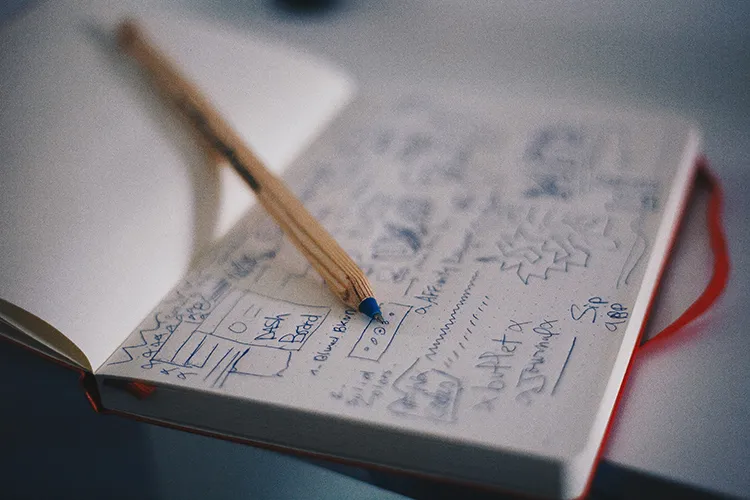
Format of a process analysis essay
For this type of essay assignment, you will not be following the traditional five-paragraph essay outline. There is still an introduction and body to your essay, but your conclusion is more like the "analysis" part and the essay will end when you've completed explaining the steps involved in a process. Below, we'll break down exactly what should be included in each of these parts. Also keep in mind that you can still create an outline before beginning writing your process analysis essay, although it might look more like a list of bullet points rather than a traditional five-paragraph essay outline.
Introduction
The introduction to your process analysis essay will include information about the process you are analyzing and why it is important. This will likely be the shortest part of your essay. If there is a unique history to the process you'll be analyzing, the introduction is where you might mention that. You basically want to use this paragraph as a brief introduction to your reader of 1) what process you'll be analyzing and 2) how or why that process might be useful information to know.
The body of your process analysis essay will mention any prerequisites, materials, or instruments needed to complete the process. It should also mention any risks or warnings involved that are relevant to the process. It's important to include everything that the reader will need to complete the process, and even extra tools that might help the process go smoother but are not necessary. For example, in the sample process analysis essay provided below on how to make apple butter, I included a spoon to stir the butter as part of the list of tools that will be needed. Additionally, I mentioned that a food processor will make the apple butter cook better and have a more butter-like consistency, but it's not necessary to have as a tool to cook apple butter.
Following these sections, you'll write the actual process in sequential order required to complete the task. Make sure you include transitional words within and between paragraphs, as these are required to show the sequence of the process in logical order. Your analysis will likely be across several paragraphs, so make sure each paragraph describes a separate part of the process to avoid confusion for your reader.
Sample process analysis essay
To show you how a process analysis essay might look, we've provided a sample essay that includes the separate sections discussed above. Notice that the introduction paragraph is short, providing basic information about the process that will be discussed, while the remaining paragraphs are longer and more detailed.

Sample essay
Apple butter is similar to apple sauce but is different in that it is highly concentrated and used more often as a butter-like topping on bread or crackers. It's cooked long and slow, allowing the sugar in the apples to caramelize and turn it a deep brown color.
To make apple butter, you will need a slow cooker, food processor, cutting board, peeling knife, large spoon, apples, sugar, and spices for the desired flavoring (usually cinnamon and nutmeg). You might also want to use an apple slicer, which cuts down on the preparation time. Note that when you begin cooking your apple butter, the more minced the peeled apples are, the smoother the final product will be. If you want your apple butter to have a true butter-like consistency, mince the apples well in the food processor before cooking.
Now, let's look at the process of cooking apple butter. To begin, prepare a large, clean space for cutting and processing the apples. Five to six cups of fresh apples will likely only result in a few cups (at most) of apple butter, so depending on how much butter you want to make, you could be peeling and preparing apples for several hours. Each apple will need to be sliced, peeled, and minced in a food processor for maximum butter-like consistency.
Next, add the minced apples to a slow cooker and place the slow cooker on "high". You will notice that the top of the mixture is watery, once the larger pieces settle. Add sugar and spices until you reach the taste you want for the apple butter. Keep in mind that apples vary in sweetness, depending on what type of apple you are using, and sugar can be added slowly throughout the cooking process. Be careful not to add too much sugar at first, as the butter will get sweeter as the apples cook down. In fact, you might even choose to not at sugar at all at this stage of the cooking process, especially if you want a final product that is not too sweet. The spices can also be added as the apple butter cooks or not at all (if that's your preference). Be sure to stir every 10-15 minutes during the first hour as the apple butter is cooking on high and let it cook uncovered.
After one hour of cooking on high, turn the slow cooker to low and cover it. Depending on the type of apple you have used, it should cook for 8-10 hours, until there is no water left at the top and around the sides of the slow cooker. During this slow cooking time, stir occasionally (once per hour should be fine). This is also when the apple butter makes your kitchen smell amazing!
Finally, when the apple butter has reached the consistency and taste you want, remove it from the slow cooker. If you choose to can the apple butter, you can do that immediately or keep the apple butter in the refrigerator until you are able to can it.
Related Posts

Mastering the APA Style Title Page: A Comprehensive Guide

120 Compelling Topics for Your Next Argumentative Essay
- Academic Writing Advice
- All Blog Posts
- Writing Advice
- Admissions Writing Advice
- Book Writing Advice
- Short Story Advice
- Employment Writing Advice
- Business Writing Advice
- Web Content Advice
- Article Writing Advice
- Magazine Writing Advice
- Grammar Advice
- Dialect Advice
- Editing Advice
- Freelance Advice
- Legal Writing Advice
- Poetry Advice
- Graphic Design Advice
- Logo Design Advice
- Translation Advice
- Blog Reviews
- Short Story Award Winners
- Scholarship Winners

Need an academic editor before submitting your work?
How to Write a Process Essay?
18 June, 2020
14 minutes read
Author: Tomas White
What is a “process essay”? What makes it different from dozens of other papers you create on a daily basis? What are its main components and what the main goal of this type of writing you need to bear in mind? If you're looking for answers to these questions, you're in luck! You can get them all from our academic guide on how to write a process essay.

Composing a process essay can be rather complicated especially if you are not familiar with this type of writing and do not know what pitfalls and specifications to pay attention to.
That is why our custom essay writing service has created this guide to help you tackle this task. We will answer all these questions in our article below and even provide you with great process essay examples and topics you can write on to stand out. So, if that sounds like something you need right now, read on: we are here to help and equip you with knowledge!
But first things first. Since it is impossible to create an excellent process essay without crystal clear understanding of the term, we will start with the definition. So, let’s dive in!
What is a process essay?
A process essay is commonly written either to explain how something works or to guide a reader through the process of completing a particular task, states the process essay definition.
Process essays also go under the “How-to articles” title and aim to teach the target audience how to achieve certain goals or complete specific assignments.
So, look at it like this. In case of “How to quit smoking” process essay, your primary goal is to provide several helpful ways of quitting this habit. These might be evidence-based recommendations if you have experience in this area, or simply common sense ideas you found while conducting your research.
Now that you realize what you will be working with, let’s look into different types of process essays and practical ways to compose them. Our essay writing guide will walk you through the process essay writing step by step.
Types of process essays
There are two main types of such papers: the ones that explain how something works , and those that show you how to complete a particular task .

1. How to do something.
Though it sounds quite self-explanatory, we’d like to emphasize the importance of clear instructions in case you are writing a process essay.
Your readers must be able to follow your guidance and complete each step successfully. So, split the process into small steps, keep it short and to the point at each stage of crafting a process essay.
For instance, in a “How to quit smoking” process essay , you can split the whole process into seven steps:
- Choose a date for a quit day;
- Imagine life without cigarettes and expect it;
- Have one last cigarette as a “Goodbye!”;
- Be among people to support you;
- Keep your goal in perspective not to give up;
- Don’t fall for substitutes;
- Be accountable.
2. How something works.
By contrast, this is an informative type of writing that aims to achieve one goal – explain the principle of work behind some process. Unlike the mentioned above type, this process essay type does not encourage a reader to take an action and do something step by step.
However, you must make sure that by the end of your essay, the audience will know for sure how something functions.
As an example of this type of a process essay, let’s see how an earthquake happens .
- First, the energy within the earth core builds up due to various moves in the earth crust;
- The energy level grows up and causes tension in the tectonic plates;
- After some time, the pressure radiates outwards by moving the plates from each other;
- The seismic waves shake the earth as they get from the core of the earth to the surface;
- That is when the earthquake takes place.
Before we go any further, let’s look at another example. In case of “How to prepare for a vacation” process essay, your task is to compose a few steps that your readers can take when getting ready for their vacation. In other words, you are describing how to do something.
Meanwhile, “What happens to your brain when you sleep” process essay is merely an explanation of the principle. In it, you are not encouraging readers to take any actions whatsoever. So, here is the fundamental difference.
How to write a process essay?

Getting started with process essay writing
When developing a process essay outline, take some time to answer the following questions:
- Who is your target audience? How deep is their knowledge of the subject? The complexity of your essay depends on their skills level. Thus, for instance, when explaining to your peers how to stretch a dollar to see the world, you can use basic terminology and examples they can relate to. However, your vocabulary should be way more sophisticated if you are writing a process essay on how to improve the overall quality of higher education in your state to the City Council.
- How can you divide the process into small steps? You do not want to bore your audience to death with unnecessary details in a process essay. Yet, you cannot afford to skip valuable steps if they are crucial to the overall understanding of the subject of your process essay. So, try to find the golden cut and figure out the most suitable amount of steps.
- What sources will you use for the task? It goes without saying that you can only use reliable sources to support your argument in a process essay. These sources should be all mentioned in the end of your essay. And remember about proper in-text citation styles. Read the materials carefully and take only the information that will add value to your essay and helps make it shine.
How to write a process essay outline
Finally, let’s look into the process essay structure. Needless to say that you must start with something that will grab readers’ attention, or in other words, “a hook.”
It is true for any essay, and process essay writing is not an exception.
The structure of your essay regardless of the process essay topics should consist of:
- A powerful introduction.
- Main body paragraphs.
- An interesting conclusion.
Related Post: Essay outline | Research Paper outline
Sounds simple, yet there are several things you should not forget about process essay writing.
How to write an introduction to a process essay
Once you compose a hook, mention why you believe that readers should use your approach to solve a problem even though there are dozens of other ones. We know two effective ways to achieve this in your process essay:
- Show how much time this task will take . People don’t have all the time in the world to tackle just this one task. So, you’ll really help them by stating how much time completing something using your approach will take and underline that with your approach described in a process essay it will take less time than if they opt for a different one. “Writing can be tough, especially if you always felt that it is not exactly your suit. However, Michael D. Pollock, a credible expert in this area, has recently presented 10 effective tips that will help you learn writing fast and make you able to craft a 1000-word article in 30 minutes. So, keep reading to find out how you can write this fast too.”
- Introduce your audience to the historical background of the approach (if any) you’re using in a process essay. Let them see the roots of your solution. Here is what a good introduction of a process essay should look like: “Giving a speech with lots of eyes concentrated on you is not an easy task. No wonder so many students dread this task. However, speech can be a powerful tool, and we can teach you how to give them right. Steve Jobs is known as one of the best public speakers of our time. People were sitting on the edge of their seats when he spoke. And we’ll teach you how to grab attention like he did using just five simple tricks he applied.”
At last, compose an engaging thesis of a process essay. Many students consider it a scary part. But it all goes down to this.
Your thesis statement should reason why your way is the best and why readers looking for answers should search no more and give your solution a chance.
It’s easier than you think. Here is a good thesis statement example:
“With more than 580 million tons of household waste produced all over the world, Every tiny effort you make to become eco-friendly counts. And if you don’t want to spend extra money on sustainable products but want to save the environment, use our guide on ten simple eco-friendly steps you can do daily without even noticing it!”
This is what a thesis statement for a process essay on how to be eco-friendly would look like. Yours can be different, but you get the idea!
How to plan main body paragraphs
- Dedicate one body paragraph to one point you want to bring to light.
- Provide enough details on each step including the ultimate goal of this step and reasons why this method was chosen for its achievement.
- Keep it short and to the point.
How to write a conclusion
Now is that time you reminded the readers about the purpose of a process essay, reasons why you chose this particular approach, and briefly mentioned steps needed to accomplish the task.
Besides, you can call your audience to action but only in case you are writing an essay that shows how to do something. Otherwise, it will be inapplicable.
Finally, help them set their expectations right: what results can they count on in the end? How long will it take them to achieve those results after reading your process essay and applying its tips?
How to use transition words in a process essay
Transition words can help you create a seamless reading experience. You can take readers smoothly from one step to another. And what is more you can help them immerse into the process!
Therefore, begin each new paragraph with a transition word, add one in between examples you provide, and summarize your instructions with them, too.

Think of transition words as of bridges that connect paragraphs and sentences. They make smooth communication between the two possible. And with them in your process essay, no reader feels irritated or frustrated with your writing style, as they have to stumble upon every other sentence in your piece.
Good process essay topics
It is not enough to just know the theory to create a good process essay. One should also come up with a topic that will be both interesting and useful to his readers. Here’s a list of our suggestions on process essay ideas:
- How to choose a perfect future career.
- How to survive college and stay sane.
- How to eat healthy on campus.
- How to balance your social and academic life.
- How to pay out a student loan while still at college.
- How to improve your public speaking skills.
- How to see the world with only $100 in your pocket.
- How to learn a foreign language.
- How to renovate your apartment and not go bankrupt.
- How to start your own business.
- How to prepare for your first interview.
- How to get volunteers to help you clean the neighborhood.
- How to write a life list.
- How to set boundaries in the relationship.
- How to study overseas for free.
Related Posts: Argumentative essay topics | Compare&Contrast essay topics
Process essay writing tips
Wrapping up, we would like to introduce you to a couple of vital recommendations on process essay writing:
- Your process essay subject cannot be too broad or too narrow. Look out for the golden cut!
- Introduce your readers to possible complications of the process. After all, forewarned is forearmed.
- Create a short vocabulary your audience can use in case they are not familiar with the terminology essential to the general understanding of the process essay in question.
- Develop a list of resources your readers will need as they deal with certain tasks. This way you will have them prepared to put your recommendations to action right away.
- Always write a process essay using Active Voice!
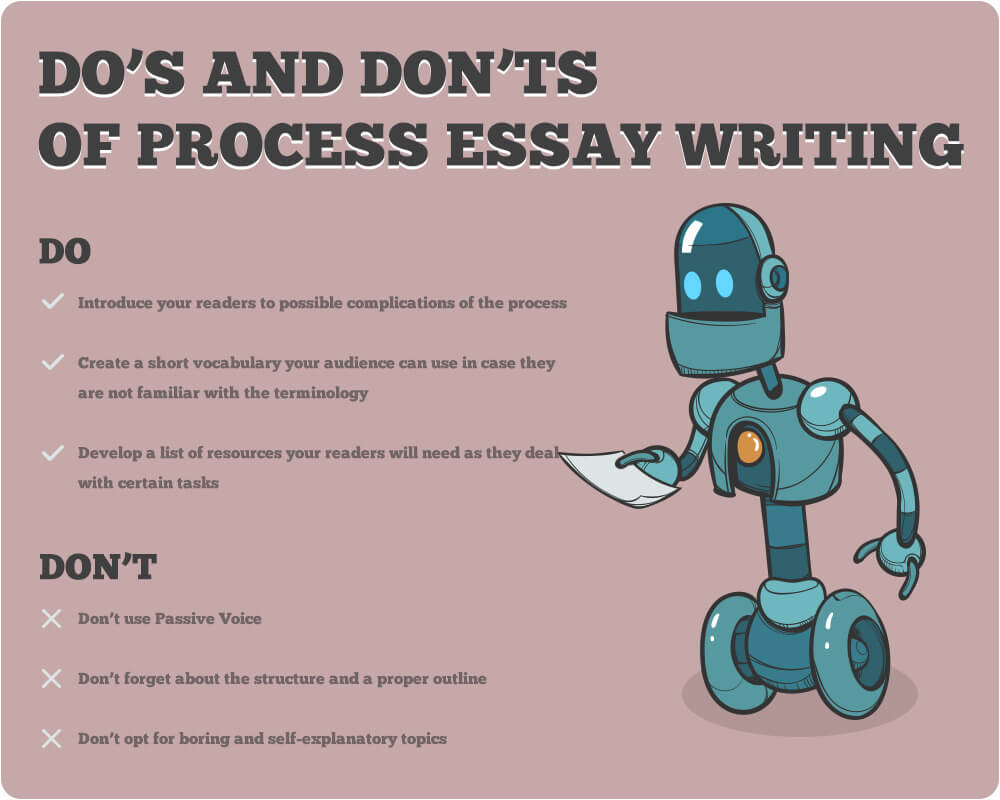
Need help with your process essay writing? Handmadewriting is here for you to help. Drop us a line to get our professional essay writers to develop an excellent piece for you!

A life lesson in Romeo and Juliet taught by death
Due to human nature, we draw conclusions only when life gives us a lesson since the experience of others is not so effective and powerful. Therefore, when analyzing and sorting out common problems we face, we may trace a parallel with well-known book characters or real historical figures. Moreover, we often compare our situations with […]

Ethical Research Paper Topics
Writing a research paper on ethics is not an easy task, especially if you do not possess excellent writing skills and do not like to contemplate controversial questions. But an ethics course is obligatory in all higher education institutions, and students have to look for a way out and be creative. When you find an […]

Art Research Paper Topics
Students obtaining degrees in fine art and art & design programs most commonly need to write a paper on art topics. However, this subject is becoming more popular in educational institutions for expanding students’ horizons. Thus, both groups of receivers of education: those who are into arts and those who only get acquainted with art […]
- The Writing Process
- Addressing the Prompt
- Writing Skill: Development
- Originality
- Timed Writing (Expectations)
- Integrated Writing (Writing Process)
- Introduction to Academic Essays
- Organization
- Introduction Paragraphs
- Body Paragraphs
- Conclusion Paragraphs
- Example Essay 1
- Example Essay 2
- Timed Writing (The Prompt)
- Integrated Writing (TOEFL Task 1)
Process Essays
- Process Essay Example 1
- Process Essay Example 2
- Writing Skill: Unity
- Revise A Process Essay
- Timed Writing (Choose a Position)
- Integrated Writing (TOEFL Task 2)
- Comparison Essays
- Comparison Essay Example 1
- Comparison Essay Example 2
- Writing Skill: Cohesion
- Revise A Comparison Essay
- Timed Writing (Plans & Problems)
- Integrated Writing (Word Choice)
- Problem/Solution Essays
- Problem/Solution Essay Example 1
- Problem/Solution Example Essay 2
- Writing Skill: Summary
- Revise A Problem/Solution Essay
- Timed Writing (Revising)
- Integrated Writing (Summary)
- More Writing Skills
- Punctuation
- Simple Sentences
- Compound Sentences
- Complex Sentences Part 1
- Complex Sentences Part 2
- Using Academic Vocabulary
- Translations
Choose a Sign-in Option
Tools and Settings
Questions and Tasks
Citation and Embed Code

In this chapter, you will write a process essay. To write a process essay, think about things that you know how to do. How would you teach someone to do one of those things?
A process essay is written to teach the reader how to do something (e.g., how to break a bad habit). This essay should describe any steps that are necessary in order to complete the process.
This content is provided to you freely by BYU Open Learning Network.
Access it online or download it at https://open.byu.edu/academic_a_writing/process_essays .
Process Analysis: How to Write a Process Analysis Essay

Writing a process analysis essay sounds like a problematic task to do, but in reality, it’s just another writing assignment. In this article, our college essay writing service will explain how to write a process analysis essay, list some process analysis essay topics and give you useful writing tips and examples. But first things first — let’s start with a process analysis definition.
What Is a Process Analysis Essay
Before jumping to the How To section, let’s answer the question of what is process analysis. Process analysis is an essay which explains how something is done, how something occurs, or how something works. In this type of essay, the writer is required to present the steps of the process in sequential order, from first to last. All concepts or terms that might appear uncommon are defined.
For Example: When writing a process analysis essay about becoming a better person, you count and describe some actions — from small to bigger ones — like lifting peoples’ self esteem around you when you were young, to becoming a motivational speaker when you’re older.
Sometimes, your professor will assign you a process analysis topic. And sometimes, you will have to pick a topic by yourself.
You should also read the article on discursive essay format . It will help expand your understanding in writing any type of paper.
Stuck on the Steps of Process Analysis?
Journey through your essay with ease. Our expert guides are ready to help you analyze every step of the way!
Process Analysis Essay Structure
Process essays may be divided into two categories: informative and directive. A directive process analysis gives instructions on how to accomplish a certain goal (for example, how to prepare the best waffles). An informational process analysis essay describes a topic to the reader (for example, how an aircraft engine functions). A process essay may be written in three easy steps:
- Split the task
The workflow should be broken down into simple, well-defined phases that generally maintain a temporal sequence and have a clear objective. You can better arrange the document with a process paper outline.
- Make smooth transitions
A process analysis essay remains more engaging when you use transitional terms—the audience benefits from phrases like - therefore, subsequently, afterward, etc.
- Study the essay thoroughly
Inspect any potential gaps, such as missing ingredients from a recipe, by going through the process essay point by point.
Process Analysis Essay Examples
Referring to an example can save you time. Our free samples can provide insight into what a process analysis essay should look like.
How to Pick a Process Analysis Essay Topic
Imagine you need to describe something in steps: what would they be? Don’t rush with making a final decision and try to rationalize your choice by following our recommendations:

- Pick a topic you have a good understanding of.
- Choose a theme that will involve the readers.
- Focus your topic on a specific thing.
- Make sure you can explain your topic without pictures. Focus on words.
- Ensure that the topic is helpful and has practical worth.
- Your topic must be relevant. If you decided to write about using a pager, we suggest you rethink your idea.
It’s okay if you don’t have a lot of process analysis essay topics in mind; just focus on the writing process and pick one of the ones we’ve prepared for you below.
Check out our ARTICLE TO FIND MORE ESSAY TOPIC IDEAS
Writing a Process Analysis Essay Step-By-Step
Process analysis essay structure is as follows:

Let's overview that structure in more details:
- The introductory part should explain the actual process and why it’s relevant or necessary. Avoid any unnecessary information such as the background, history or origin. If for instance, a recipe needs tomato sauce, the reader should be informed so. In other words, go directly to the issue and provide only the necessary information.
- The next paragraph should present a list of all the equipment, tools or resources necessary for the particular process. For instance, if some ingredients cannot be found in the locality, explain where you can find it, or them. Potential risks or side effects that are likely to occur in the process should be stated so that the reader remains informed. Furthermore, it is essential to inform the reader about what might go wrong and what can be done to avoid potential mistakes.
- Then, outline the process in sequential order. If the process requires some steps to be undertaken at particular stages, these should be stated and explained clearly, at relevant points in the sequence. The writer should be very keen to avoid confusion. For processes that appear complicated, the steps should be subdivided accordingly. Additionally, the writer needs to vary their use of transitional words such as “after”, “then”, “next” to make sure the essay does not become repetitive.
- The final part should present a general review of the whole process so the writer can reinforce the main points succinctly, without details.
You can also read the essay example from our essay writer . If you still need help, contact us and we will do everything in the best way.
Process Analysis Essay Outline
The structure for this type of analysis essay outline is as follows:
Introduction:
- Introduce your topic and briefly outline what the process will achieve.
- Demonstrate where this process is relevant or when it is useful.
- It’s a good idea to offer a real-world example of the outcome of the procedure.
- The processes should be presented in paragraphs.
- Perform each step in its section.
- Appropriate transitions should be employed for each step.
- Be descriptive in your presentation.
Conclusion:
- In your conclusion, summarize the procedure. You don’t have to repeat all the individual steps, but you need to reinforce the main points and milestones.
- Describe the expected result.
Writing Tips
- Appropriate Use of Language and Vocabulary Making good use of vocabulary and technical terms can often make or break an assignment. This impacts the degree of depth and clarity the reader can get out of it. Thus, if your audience is meant to be doing the procedures while reading, the steps should be simple and to the point.
- Give the Reader a Sense of Direction When including comments in your essay that are tailored to give a sense of direction, like “once that’s done” or “wait until”, it’s best to do so where relevant. Try to avoid over-complicating the steps, while keeping everything clear and concise.
- Use Chronological Progression For example, if it’s a cooking recipe, it should always include the steps in sequential order, while also indicating how much of each ingredient to add. Additional information like cooking techniques can be added at the end—to be as detailed as necessary.
Need a hand? Leave us a notice ' write my dissertation ' and we'll help asap.
Process Analysis Got You Puzzled?
Break down complex processes into simple, understandable essays. Let our professionals illuminate the path!
Related Articles
.webp)

- school Campus Bookshelves
- menu_book Bookshelves
- perm_media Learning Objects
- login Login
- how_to_reg Request Instructor Account
- hub Instructor Commons
- Download Page (PDF)
- Download Full Book (PDF)
- Periodic Table
- Physics Constants
- Scientific Calculator
- Reference & Cite
- Tools expand_more
- Readability
selected template will load here
This action is not available.

3.4: Process Essay
- Last updated
- Save as PDF
- Page ID 6721

- Kathryn Crowther et al.
- Georgia Perimeter College via GALILEO Open Learning Materials
The Purpose of the Process Essay
The purpose of a process essay is to explain how to do something (directional) or how something works (informative). In either case, the formula for a process essay remains the same. The process is articulated into clear, definitive steps.
Almost everything we do involves following a step-by-step process. From learning to ride a bike as a child to starting a new job as an adult, we initially needed instructions to effectively execute the task. Likewise, we have likely had to instruct others, so we know how important good directions are—and how frustrating it is when they are poorly put together.
Exercise 10
On a separate sheet of paper, make a bulleted list of all the steps that you feel are required to clearly illustrate three of the following four processes (note that the first three are directional and the fourth is informative).
- Tying a shoelace
- Parallel parking
- Planning a successful first date
- How a historical event occurred (pick one you know well!)
The Structure of a Process Essay
The process essay opens with a discussion of the process and a thesis statement that states the goal of the process. The organization of a process essay typically follows chronological order. The steps of the process are conveyed in the order in which they usually occur, and so your body paragraphs will be constructed based on these steps. If a particular step is complicated and needs a lot of explaining, then it will likely take up a paragraph on its own. But if a series of simple steps is easy to understand, then the steps can be grouped into a single paragraph.
The time transition phrases covered in the Narration section are also helpful for organizing process analysis essays (see Table of Transition Words and Phrases for Expressing Time). Words such as first, second, third, next, and finally are cues to orient readers and organize the content of the essay.
Finally, it’s a good idea to always have someone else read your process analysis to make sure it makes sense. Once we get too close to a subject, it is difficult to determine how clearly an idea is coming across. Having a peer read over your analysis will serve as a good way to troubleshoot any confusing spots.
Exercise 11
Choose two of the lists you created in Exercise 10 and start writing out the processes in paragraph form. Try to construct paragraphs based on the complexity of each step. For complicated steps, dedicate an entire paragraph. If less complicated steps fall in succession, group them into a single paragraph.
Writing a Process Essay
Choose a topic that is interesting, is relatively complex, and can be explained in a series of steps. As with other rhetorical writing modes, it is best to choose a process that you know well so that you can more easily describe the finer details about each step in the process. Your thesis statement should come at the end of your introduction, and it should state the final outcome of the process you are describing.
Body paragraphs are composed of the steps in the process. Each step should be expressed using strong details and clear examples. If you are writing a directional essay, you should provide every detail necessary for your reader to complete the process. If you are writing an instructional essay, your body paragraphs should explain the process and how it works, although you should not expect your reader to be actually performing the process. Use time transition phrases to help organize steps in the process and to orient readers. The conclusion should thoroughly describe the result of the process described in the body paragraphs. See the student paper below, “Keep Them in Stitches,” or one of the sample professional essays to read an example of a process analysis essay.
Exercise 12
Choose one of the expanded lists from Exercise 11. Construct a full process essay from the work you have already done. That means adding an engaging introduction, a clear thesis, time transition phrases, body paragraphs, and a solid conclusion.
Sample Process Essay
“Keep Them in Stitches,” by Jacob Gallman-Dreiling, describes the process of finding the perfect yarn for a knitting project. As you read, pay attention to the words and phrases the author uses to help orient the reader, as well as the strong details that bring the subject to life.
Jacob Gallman-Dreiling
English 1101
24 February 2013
Thesis statement: Choosing the perfect yarn for a knitting project relies on the preferences of the person for whom the project is being made, the availability of the yarn, and the type of yarn called for by the pattern.
- Wool yarn will aggravate allergies to lanolin.
- Acrylic yearns can be scratchy or leave splinters.
- Warmer items should be made with animal fibers.
- Lighter items should be made with cotton.
- Wool yarn should be hand washed with cold water.
- Cotton and acrylic yarns are machine washable.
- Solid colors are great for sweaters and accessories like professional iPad cases.
- Variegated yarn makes for show-stopping pieces and can help maintain the knitter’s interest through the end of the project.
- An advantage to shopping in person is the ability to touch the yarn.
- An advantage to shopping at the local yarn store is the knowledgeable staff, many of whom have been knitting for years.
- An advantage to shopping at the yarn store is that the staff can provide ready assistance and often have first-hand knowledge of the yarn the knitter intends to use.
- Online retailers typically have greater stock availability.
- Online retailers also provide tutorial videos.
- Fingering, sport, and DK weight yarns are good for smaller projects like socks or baby clothes.
- Worsted, bulky, and super bulky are great for sweaters, scarves, blankets, and washcloths.
- Some people prefer sweaters with a small gauge.
- Some people prefer socks with a large gauge
Keep Them in Stitches
The popularity of knitting is cyclical, rising and falling according to the prevailing opinion of women’s places in society. Though internationally a unisex hobby, knitting is pervasively thought of as a woman’s hobby in the United States. Knitting is currently enjoying a boost in popularity as traditionally minded women pick up the craft while women who enjoy subverting traditional gender roles have also picked up the needles to reclaim “the lost domestic arts” and give traditionally feminine crafts the proper respect. American men are also picking up the needles in greater numbers, with men’s knitting guilds and retreats nationwide. This rise in popularity has made the receiving of hand-knit items special, and many people enjoy receiving these long-lasting, painstakingly crafted items. For any knitters, the perfect gift starts by choosing the perfect yarn. Choosing the perfect yarn for a knitting project relies on the preferences of the person for whom the project is being made, the availability of the yarn, and the type of yarn recommended by the pattern.
In order to select the right yarn for a knitting project, the knitter must take into account the preferences of the recipient of the knitted item. The most basic choice is the composition of the yarn to be used. Natural fibers are luxurious and tend to age better. Nevertheless, the knitter must determine if the recipient has any allergies or sensitivities. Wool yarn, for example, will aggravate allergies in those sensitive to lanolin, but mohair, alpaca, cotton, or angora will not cause discomfort. Acrylic is a synthetic yarn, but it can be scratchy or leave splinters. A second consideration is the type of project the knitter plans to complete: each project requires a specific type of yarn. For warmer items such as sweaters, blankets, or mittens, animal fibers are best. Socks, warmer-weather items, and household accessories are best served using cotton. One must also give thought to the care of the finished project. Items made from wool yarn survive best when hand washed in cold water whereas cotton and acrylic items are machine washable.
Once the type of yarn has been chosen, the knitter should consider what color yarn the recipient prefers. A solid color garment looks more professional and functions as a base piece in a wardrobe or interior design. Sweaters, iPad and tablet cases, as well as belts are well-suited to solid colors. Pieces made with variegated colors, in which the yarn has either multiple colors or shades of the same basic color, make for show pieces and accessories. Socks, gloves, scarves, and cowls are great projects for variegated yarn. Variegated yarn colors tend to keep the knitter’s interest, but multicolored yarn can be difficult to use when working on larger projects which require multiple skeins of yarn. Due to the way yarn is dyed, the color at the end of one skein may not match the color at the beginning of the next skein.
The next step in determining the right yarn for a project is availability, particularly where to purchase the yarn. Some people prefer to shop at a local store for yarn because it offers many advantages. Shopping in person allows the knitter to feel the yarn he or she intends to purchase. This can help sway the knitter’s opinion in regards to yarn choice. The staff at a local shop is often knowledgeable; many of them have been knitting for years, and they are usually ready to offer assistance with projects or yarn selection. If a knitter does not live near a yarn store, there are many online retailers who can fulfill their orders. Online retailers typically have a larger selection of yarns and patterns available for download. Since they cannot give personal assistance, many compensate for this deficiency by providing free tutorial videos.
Finally, choosing the right yarn for a project relies on the type of yarn called for in the knitting pattern. Patterns are highly adaptable. Most things in a pattern can be substituted: yarn type, yarn weight, color, and number of stitches can all be substituted to fit the knitter’s desire, but the pattern will provide a good place to start. The yarn weight, which determines the gauge of the project, is one of the most basic substitutions. Fingering or lace weight, sport, and DK weight are lighter weight yarns typically good for smaller projects like socks or baby clothes. Those types of yarn tend to be knit on smaller needles and produce a smaller stitch. Worsted, bulky, and super-bulky yarns are chunkier, knit on larger needles, and provide beautiful, large stitches. They are well suited for sweaters, scarves, blankets, and washcloths. The preferences of the recipient must also be taken into account. Some people prefer sweaters with a small stitch, while others prefer thick, warm socks to wear around the house.
The right yarn for a knitting project is one that meets the preferences of the recipient of the project, is readily available, and matches the needs of the pattern. After the project is completed and given to the intended recipient, both the knitter and receiver can bask in the adulation the finished garment brings. These hand-knit items can be passed down for several generations, truly becoming a gift that keeps on giving.
Online Process Essay Alternatives:
Stanley Fish, an American literary theorist, public intellectual, and professor of humanities and law, tells us why “Getting Coffee Is Hard to Do.”
50 Great Topics for a Process Analysis Essay
Illustration by Jiaqi Zhou. ThoughtCo.
- Writing Essays
- Writing Research Papers
- English Grammar
- Ph.D., Rhetoric and English, University of Georgia
- M.A., Modern English and American Literature, University of Leicester
- B.A., English, State University of New York
If you've ever read an instruction manual or written a set of directions, then you are probably familiar with process analysis writing. This form of composition is often used in the field of technical writing to explain the process of a complex system logically and objectively. Because the material covered in process analyses can be quite complicated, this type of writing tends to be detailed and long.
What Is Process Analysis Writing?
Process analysis writing involves a comprehensive set of instructions that explains a process from beginning to end. To successfully write a process analysis essay, writers must critically analyze each step of the process they have chosen to describe and determine the most reasonable way of delivering information before writing. Expertise is required when explaining a process with this level of detail and this can be obtained through firsthand experience or thorough research.
The topic of a process analysis essay needs to be as specific as possible and it is crucial that the tone of the essay be clear and straightforward. A writer's main goal when crafting a process analysis essay should be to make a process easy to follow. Below is a set of tips that will help you achieve this.
Tips for Writing a Process Analysis Essay
When writing an essay or speech through process analysis , keep these tips in mind:
- Include all steps and arrange them in chronological order .
- Explain why each step is necessary and include warnings when appropriate.
- Define any terms that may be unfamiliar to readers.
- Offer clear descriptions of any required tools or materials.
- Give your readers a way to measure the success of the finished process.
50 Process Analysis Essay Topics
Writers will have an easier time writing process analysis essays and following the above guidelines for topics they know well. To begin, choose a subject that you enjoy writing about and know that you can explain well. These prompts offer potential process analysis essay topics to get you started.
- How to mow your lawn
- How to win a game of Texas hold 'em poker
- How to lose weight without losing your mind
- How to find the perfect roommate
- How to get rid of a roommate—without committing a crime
- How to achieve academic success in college
- How to pitch a knuckleball in baseball
- How to plan the perfect party
- How to survive a night of babysitting
- How to pitch a tent in the rain
- How to housebreak your dog
- How to kick a bad habit
- How to overcome insomnia
- How to stay sober on a Saturday night
- How to rent your first apartment
- How to avoid a nervous breakdown during exams
- How to enjoy the weekend for less than $20
- How to make the perfect brownies
- How to keep resolve arguments with your spouse
- How to bathe a cat
- How to get what you want through complaining
- How to survive a recession
- How to toilet train a baby
- How to gain self-confidence
- How to use Twitter sensibly and effectively
- How to wash a sweater
- How to remove stubborn stains
- How to build successful relationships with instructors
- How to give yourself a haircut
- How to plan the perfect class schedule
- How to apply the Heimlich maneuver
- How to end a relationship
- How to make a flaky pie crust
- How to take the best photographs with a smartphone camera
- How to quit smoking
- How to get around without a car
- How to make the perfect cup of coffee or tea
- How to maintain an eco-friendly and affordable lifestyle
- How to build a great sandcastle
- How to edit a video
- How to build and maintain a stable friendship
- How to insert contact lenses
- How to write a great exam
- How to teach responsibility to a child
- How to groom your dog
- How ice cream is made
- How a cell phone takes pictures
- How a magician saws a woman in half
- How solar panels work
- How to choose a major in college
- 501 Topic Suggestions for Writing Essays and Speeches
- Evaluating a Process Analysis Essay
- Process Analysis Essay: "How to Catch River Crabs"
- How to Write a Great Process Essay
- List of Topics for How-to Essays
- How to Break in a New Baseball Glove
- Process Analysis in Composition
- A Sample Essay for Common Application Option #7: Topic of Your Choice
- Tips for the Pre-2013 Personal Essay Options on the Common Application
- Topical Organization Essay
- Expository Essay Genre With Suggested Prompts
- Common Application Essay Option 6: Losing Track of Time
- MBA Essay Tips
- How to Write a Narrative Essay or Speech
- How to Write an Instructional Outline
- Composition Type: Problem-Solution Essays
- Essay Guides
- Main Academic Essays
How to Write a Process Essay: Useful Tips and Examples
- Speech Topics
- Basics of Essay Writing
- Essay Topics
- Other Essays
- Research Paper Topics
- Basics of Research Paper Writing
- Miscellaneous
- Chicago/ Turabian
- Data & Statistics
- Methodology
- Admission Writing Tips
- Admission Advice
- Other Guides
- Student Life
- Studying Tips
- Understanding Plagiarism
- Academic Writing Tips
- Basics of Dissertation & Thesis Writing
- Research Paper Guides
- Formatting Guides
- Basics of Research Process
- Admission Guides
- Dissertation & Thesis Guides

Table of contents
Use our free Readability checker
A process essay is a type of expository writing that explains a series of steps or procedures to achieve a particular outcome or complete a task. It provides detailed, step-by-step guidelines for the reader to follow.
If you want to understand how to write a “how to” essay, the best solution is to turn for help to the professional academic essay writers with a rich writing experience. Review this article, which contains everything a student should know before writing your process essay.
What Is a Process Essay: Definition
Before learning how to write a process paper of A level, it is critical to define the term. A process essay refers to the type of academic writing which contains a detailed description of the particular process in the shape of the step-by-step guide. This form of essay is popular in business & technical writing. Some of the best examples of process essays include:
- Instruction/owner’s manual;
- User’s guide;
- “How to…” articles;
- Security instructions;
- Recommendations.
Students should test the process themselves before writing an instruction or manual. It would be the best answer to the question “ what is a process essay ?”
Process Essay Outline: Structuring Your Paper
There is not much to say about the process essay outline because structure repeats steps required to complete a certain procedure. Having an outline is helpful in any situation associated with academic writing. Put down every stage in chronological order. Once the student has an outline, they may later add some details depending on the process development to come up with the whole body. Maybe you will ask " How to structure an essay of this type?" The structure of a process outline is common:
- Introduction paragraph (mention the process to discuss).
- Body paragraphs (list the stage and provide details).
- Conclusion (specify what the expected outcome should be + share some success indicators).
The length of a “how to” essay depends on whether the chosen procedure is time-consuming or not. Do not pick something extra fast not to have a few-sentence essay in the end.
Process Essay Introduction
Let’s talk a little about the process essay introduction. It does not matter whether an essay is describing the way to get chocolate out of milk and coconuts, explaining some procedure of vaccination, or interpreting steps required to write a book. It is important to identify the target audience from the start! If it is an average user, avoid difficult terms. In case you write to satisfy the curiosity of advanced users, do not mind including various professional terms to prove your competence in the chosen field. Do not worry about structure. The best thing about this type of academic assignment is that step-by-step process itself provides a student with correct structure. Still, experts recommend having an outline. Would you like to know good ways to start an essay of this type? Start an opening paragraph by determining an analyzed procedure and share personal ideas on why this specific process is interesting & important to observe. Formulate a process essay thesis. It is not necessary to cover history or background of some discussed procedure.
Process Essay Body Paragraph
Do not include any details that do not relate to the process itself. If some required tools & equipment are rare, tell readers some ways to get these resources. Write down warnings about possible safety hazards to prevent readers from falling into trap/injuring. Describing steps alone might be dull. To enrich your writing, add some common mistakes to avoid. And provide helpful tips to make this process simpler & quicker. Main body of a process essay is usually written in chronological order. Add every step in chronological order with the help of clear words. If there are similar steps or those that can be performed at different stages, mention it to acknowledge the reader. To prevent confusing situations/failures, experts recommend subdividing the steps of especially long processes (example: Step 1A, 1B, etc.) Professional hint from essay order experts!
“A good process essay always uses the second person – “you.” It sounds more personal, and readers trust its writer. Be ready to apply a plenty of transitional words & phrases! They make this procedure description logical and clear to every reader. Try to insert different transitions to prevent text from being repetitive. During the process of writing an instruction or manual, do steps described in text to check whether everything works the way it should before offering the same actions to your target audience.” Professor Pryce, academic counselor and online writing tutors at StudyCrumb
Writing Process Essay Conclusion
Let’s see how to end writing a how-to essay. By the end of an instruction, reader/user must be able to repeat provided actions to activate the process or solve some problem alone. If readers cannot do that, it means that writer failed giving clear, correct instructions. How to start a conclusion in an essay ? Do it with some short review of an entire process from A to Z. It will help readers recall what they were doing, how long, and what expected results should be. While body paragraphs provide detailed interpretation of each stage, a conclusion must contain a single short sentence summarizing every step of a process. It should look like an opening sentence of this article.
How to Write a Process Essay: 10 Simple Steps
Process essay writing is not a difficult task. Even though a process essay is easy to write, it is crucial to know the essential steps of writing. Knowing all nuts and bolts will help you write an article quickly and correctly. Below you will find 10 basic steps you should know to write an outstanding process essay. Step 1: Think of some topic you want to write about. What interests you most? What will be useful for your readers? Consider all these questions and create the best topic. Browse our process essay topics we prepared for our users. Step 2: Start your research. Look for some sources that have relevant information. Collect all important data. Step 3: Read sources you collected carefully and analyze information. Make notes when reading and have quick access to needed information. Step 4: Create an outline for your paper. Plan your future paragraphs beforehand. Step 5: Collect all parts of your guide together and think what you may add to the main body. Write body paragraphs. Step 6: It is not a good idea to compose your introduction at the beginning. Start writing your introduction paragraph only after you have main part. Step 7: Don’t forget about a strong hook for your paper. It should be concise, informative, and grab attention of your reader. Step 8: Finally, summarize all points you mentioned in your text and create your conclusion. Highlight the result again. Show readers what they will get after they follow all steps mentioned in your essay. Step 9: After all these steps are done, create a catchy and informative title. It should not only display what your essay is about but also grab your reader's attention and make them want to read your guide. Step 10: Proofread your process essay and edit mistakes. Read your text again, check for typos and grammar mistakes. Make sure it is readable and understandable. Following these steps will help you create a truly brilliant process essay that you will get an A+ for. Buy essays papers to enjoy even higher odds to succeed with your submission.
Helpful Tips on How to Write a Process Paper
While writing this type of academic essay, recall these professional tips & tricks and earn A+!
- Say what you are doing to describe an action. It would be paper’s topic, precise, clear, and educating. Narrow down your topic if it sounds broad. Example: Instead of calling some instruction “How to Install Windows” make it “How to Install Windows 10 on the most recent Asus models (name them).”
- Get ready with outline of an essay , which is structure of your essay.
- Name requirements like resources, equipment, instruments, stuff, skills, and knowledge person will need to complete their process. If more than one person is required, mention it.
- Identify technical & professional terms in text. In case manual explains a procedure based on special, technical knowledge/skills, such as carpentry, it is better to include some definitions of some specific terms readers might not know. If your teacher allows, enrich your essay with images, signs, graphs, and tables to explain some word.
- Each good instruction should contain warnings/cautions. List all possible threats & security hazards. Along with some obstacles readers may face in the process. Use an active voice in this part.
- Finish manual/instruction with an explanation of what person should be ready to obtain once the procedure is over (stress the importance of experiment). It is important to list success factors. Example: “Cooked dumplings should not look tenderized/taste raw.”
- Add images & more techniques so readers follow instructions simpler. For instance, “peach color” may be perceived as various textures by various individuals.”
Interesting Process Essay Examples
Of course, we won’t leave you without a real example of a process essay. Only reading this article may not be enough. Before you start your writing, it is better to look at how other students organized similar works. Here is one of professional how-to essay examples shared by college students.
If you want a similar essay customized to your needs, just say " write my essays " and StudyCrumb will provide tailored assistance. Our writers prepare such orders daily and know how to make your process essay beautiful.
How to Write a Perfect Process Essay: Final Thoughts
As you see, writing a professional essay is not as difficult as you might think. This type of essay does not require some special writing skills or use of high academic language . So following our simple tips we provided in our article will help you create an excellent essay that will guide readers through some steps easily.
Get in touch with our essay writing service and have your assignment done with great quality in mind.
Frequently Asked Questions about Process Essay
1. what are good transition words for process essay.
The most appropriate process essay transition words are ones that help readers distinguish different stages of a guide described in your essay. To define stages of your paper try using following transition words:
- After that,
- Eventually,
- Afterwards,

2. How to write a thesis of a process essay?
Thesis statement for process essay should be clear, concise, and informative. In your thesis you should briefly inform a reader of result they will get after reading your guide and following all steps. Mention benefits readers will gain.
3. What is a process essay outline example?
Process essay outline example may look as follows:
- Prepare list of ingredients
- Prepare an oven
- Prepare chocolate chips or dried fruit
- Mix ingredients together
- Bake muffins
- Cool muffins
- Serve muffins.
4. What are final steps after finishing writing process essay?
After you finished writing your process essay, you still should edit and proofread your text:
- Read your text and correct mistakes and typos.
- Delete unnecessary words and sentences.
- Check your instructions again and make sure it is easy to read and understand.
- Give your paper to your friend and ask them to read it. After that ask if they fully understood all instructions. If not, make corrections.

Daniel Howard is an Essay Writing guru. He helps students create essays that will strike a chord with the readers.
You may also like


Process Essay
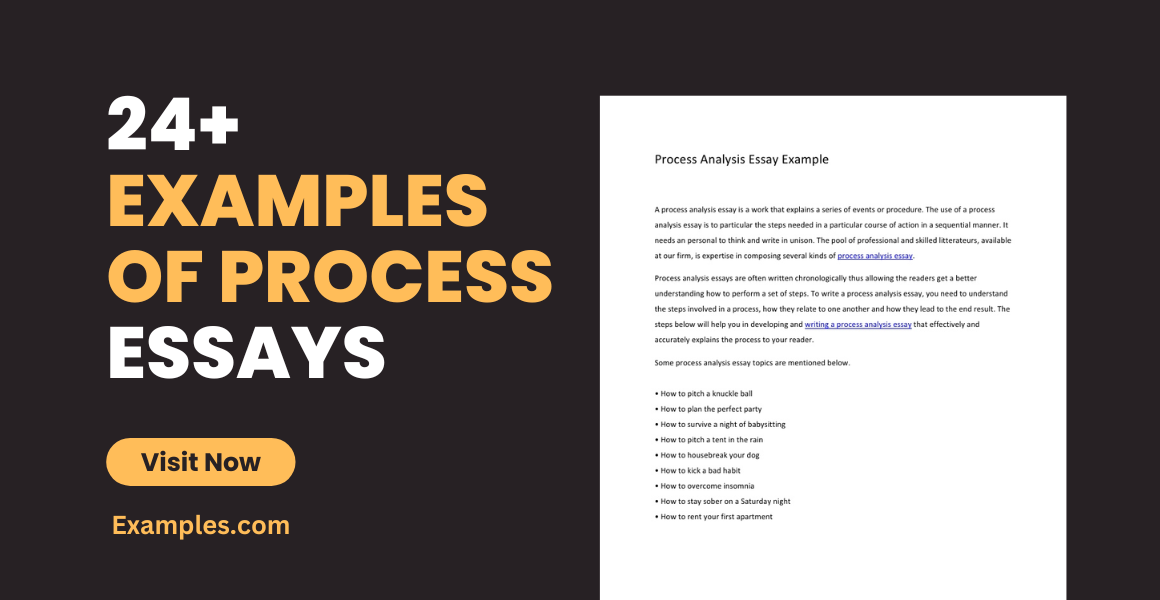
Do you know all those YouTube do-it-yourself (DIY) tutorials that they post online? When you consider posting that other than a process essay, it usually attracts more viewers and generates more subscribers on your YouTube channel as people these days are considered more visual in terms of learning new skills or facts. But process essays are just more than how-to videos or DIY videos, an accurate description of a process essay is that it simply describes a procedure. You may also see a short essay .
- 22+ examples of free essays .
- 10+ Essay Writing Examples
This kind of essay provides a step-by-step explanation of a process that leads to an expected or planned outcome. What people do not know that the aforementioned process may either be concrete or abstract. Simply put, there are two types of process essays: directional process essays (give instructions in steps on how to accomplish a specific task), and informational process essays (explains or analyzes a process). You may also see self-introduction essay
Student Process Essay Example
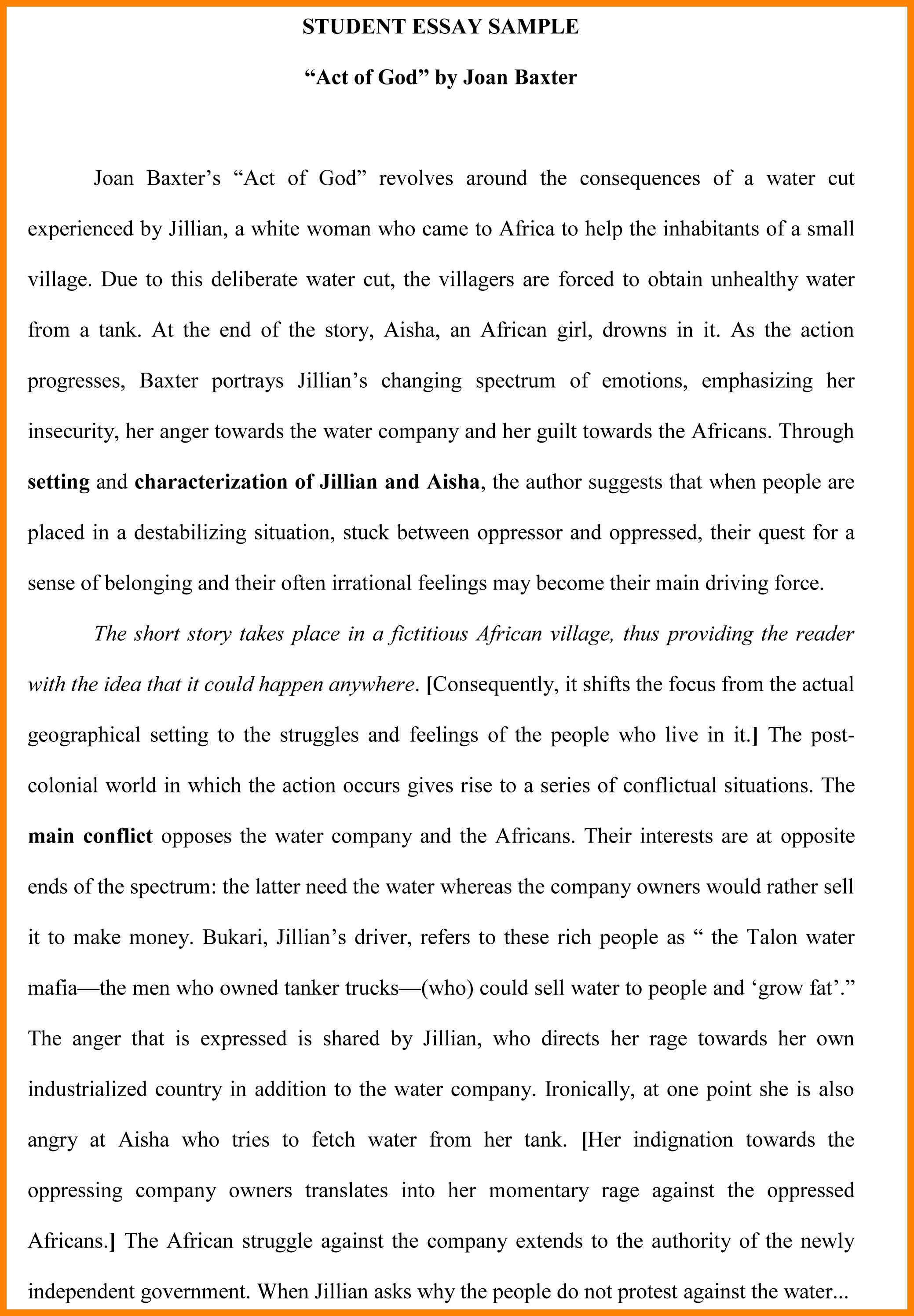
Size: 615 KB
Process Analysis Essay Example
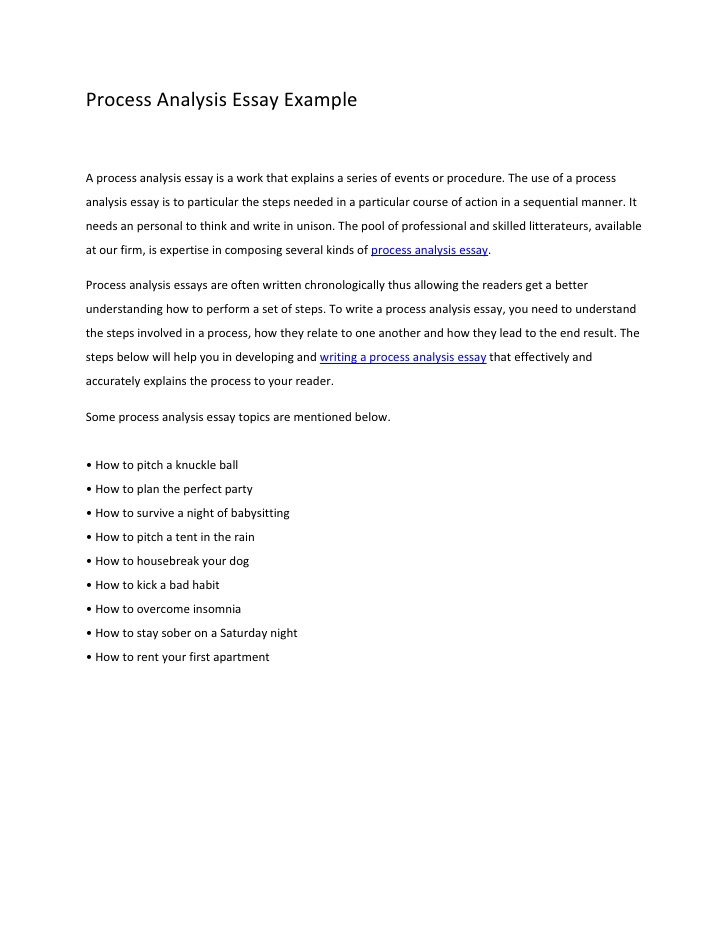
Size: 66 KB
Plain Process Essay Example
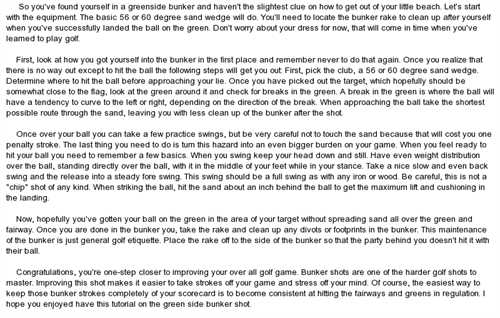
http://degregoristore.com/
Size: 53 KB
Preparation in Writing a Process Essay
1. assess your audience’s skill level.
Before you begin, you need to first take your audience’s skill level into consideration. In a lot of DIY videos and how-to videos that you see in numerous TV shows, you can see that the hosts will often make use of very simple language so that the people who decide to subscribe on their YouTube channels and watch those DIY videos will be able to understand them very easily. Another thing that you should assume is that everyone who decides to check out your videos or read your process essay has little to no knowledge of the said topic, depending on the content you decide to release or publish. Before you even begin to write your essay, you have to understand the parts that comprise an essay .
For example, a process essay intended for professional chefs could probably skip a description of how to chop carrots and just say, “Finely chop the carrots,” instead.
2. Make a list of the materials needed
If you already have an idea on what kind of process you are going to release or publish, the next thing to do would most probably be to draft a list of the materials or ingredients that your audience or viewers might need so that they can follow along. It may be easier to do so in your own DIY or “How To” videos, as it is more visual and that the viewers could clearly see as to what these products look like should they get confused, but for process essays, it is a bit tricky. One tip that you could follow would be to include a comprehensive “Things You’ll Need” section at the beginning of the paper or simply list the materials needed after the introduction so that the readers of your essay will prepare the materials needed beforehand to save precious time. There are moments in your life that you will be asked to draft up self-introduction essays as part of a class assignment.
There are times that an item on the list would seem very unusual for a person to procure. Should that be the case, such as a particular type of hand tool, be sure to clearly introduce it within the text. For instance, “The pin hammer has a finer tip than a standard hammer, making it suitable for more detailed work.” If at all possible, make sure to include a picture of the said object you are planning to use if you intend to publish the said essay online. You may also see a formal essay .
3. Create an outline of the task
In order to make things simpler for you on your end, it would be best if you created an outline that can help you create the flow of the process essay that you are working on. Keep in mind that the outline simply acts as the guide for the essay and is not the essay itself. Outlines are normally made with bullet points and at least 1 to 2 sentences per point. Creating an outline will be most helpful to especially informational process essays. Keep in mind that the more specific your article or essay topic, the more specific your details need to be. Here are some examples of how different people would write their essays .
- If your essay happens to be about cooking lasagna, you may want to begin your initial outline by saying, “Mix in basil.” Before you start writing, you could expand your outline to say, “Briefly mention taste differences between dried and fresh basil.”
- When writing an informational process essay outline about how journalists write a news report, you can include some details about journalists select a news story and the criteria they would use to determine a story’s newsworthiness.
Simple Process Essay Example
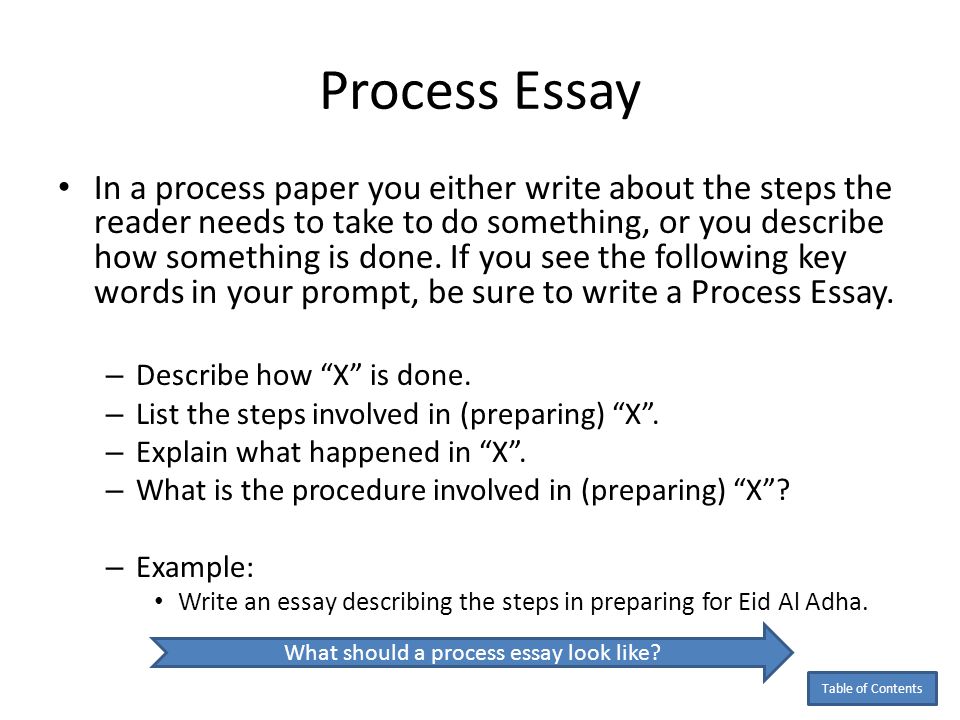
Size: 96 KB
Process Essay Example from Kool-Aid
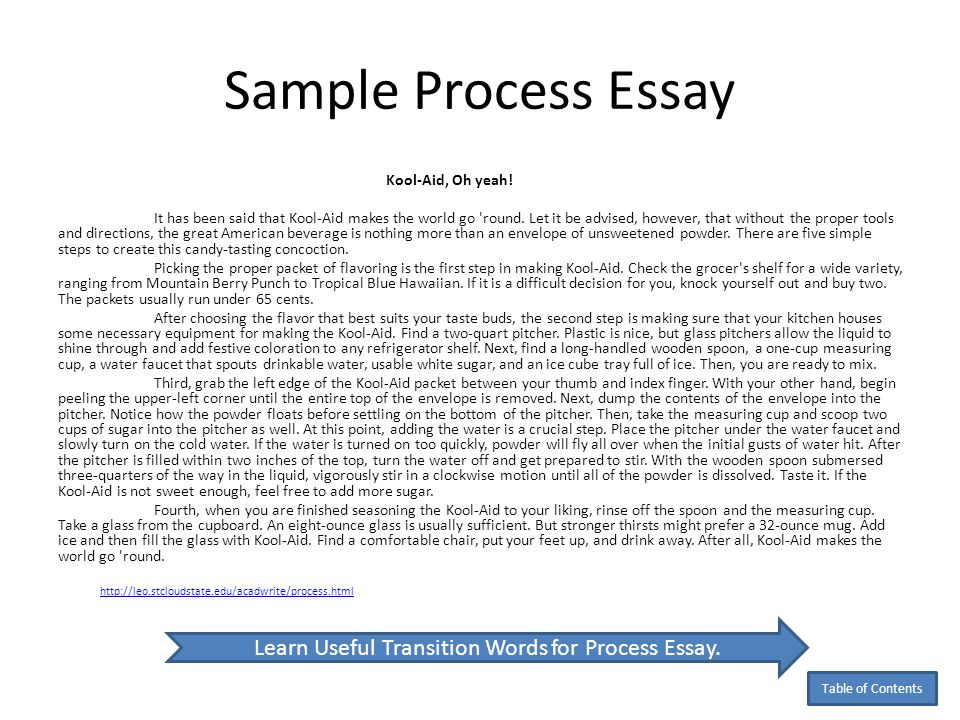
Size: 159 KB
Scanned Written Process Essay Example

Size: 76 KB
Golf Process Essay Example
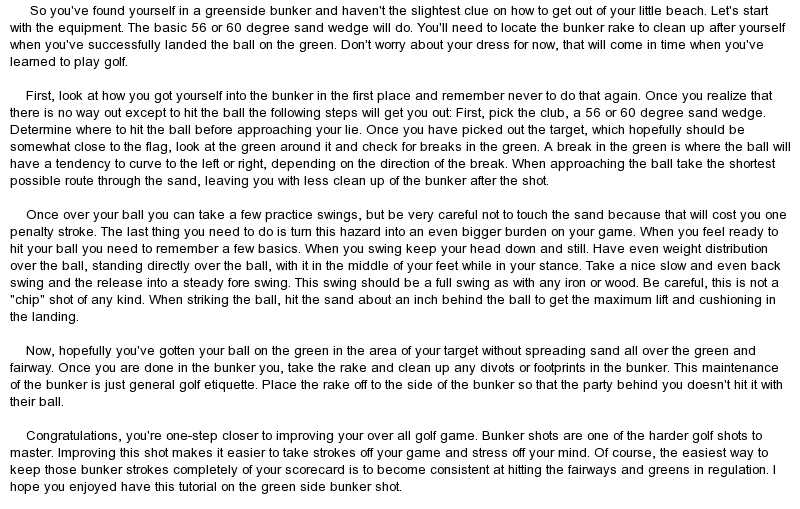
Size: 138 KB
Process Essay Example in Making Popcorn Balls
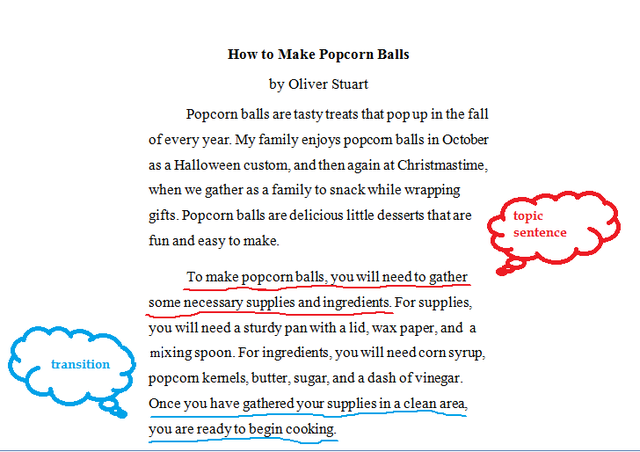
Size: 130 KB
Crafting Your Introduction
1. Grab your reader’s attention within the first 1–2 sentences. Today’s readership has a very short attention span. You see books being made into movie adaptations. Some books are being even made into TV shows for a longer and more detailed story line. Although there are some people who also prefer reading compared to watching, there are people who can tell a good book just by the first few paragraphs of the first page alone. You get that right, then you would have gained new readership. DIY and “How To” videos may be easy to create and draft a new introduction, but essays, not so much. It is usually the make or break stage for the essay. They say that when you start strong, it is just as important and vital to end strong as well. Leave the audience wanting to do more of your DIY projects or videos in the near future. Should you be interested in writing a reflective essay , you may want to click on the hyperlink on this sentence.
For instance, you might write, “The process of preparing lasagna has a rich heritage all of its own.”
2. Provide a general time estimate. Providing time estimates are very essential especially in writing these process essays as everyone might have some other plans other than doing the DIY video or following the process essay they happen to be reading. In cooking or baking, time is considered very critical. An example would be when the participants of MasterChef are asked to cook one of Gordon Ramsay’s signature dishes to avoid elimination. Even when cooking something as simple as scrambled eggs, one of the steps that Gordon suggested would be to stir over medium heat until the eggs start to cook.
The next step would be to remove the egg mix from heat and then continue stirring eggs for about 30 seconds. Return to heat, continue to stir eggs until they start to clump. He suggested that it is important to keep it “on and off” from the heat, otherwise, the eggs might be overcooked which as a result becomes watery. You would not want that to happen to your eggs, would you? Should you find yourself in need of writing an analytical essay , you may want to refer to the hyperlink found on the sentence.
3. If your process essay focuses on a cooking task, this is where you inform your audience to have some sort of clock or timer nearby for them to keep track of the number of minutes that have passed by and to place all the ingredients on the table beforehand.
4. Present the thesis statement as a problem. A thesis statement focuses your ideas into one or two sentences. It should present the topic of your paper and also make a comment about your position in relation to the topic. The thesis statement is considered to be the most important sentence of your paper as it informs the reader not only which problem you will be examining, but it should give them an idea as to how you will be able to solve the issue at hand. Your thesis statement should tell your reader what the paper is about and also help guide your writing and keep your argument focused. The thesis statement should be the last sentence of your introductory paragraph. Here are some examples of short essays that might serve as a reference in case you need assistance in formulating one.
5. You can start off your thesis statement like this, “This essay will explore how to create a complicated lasagna dish in a short period of time by preparing the noodles and sauce in advance.”
The Writing Process
Size: 25 KB
Pros and Cons of Adoption Essay Sample
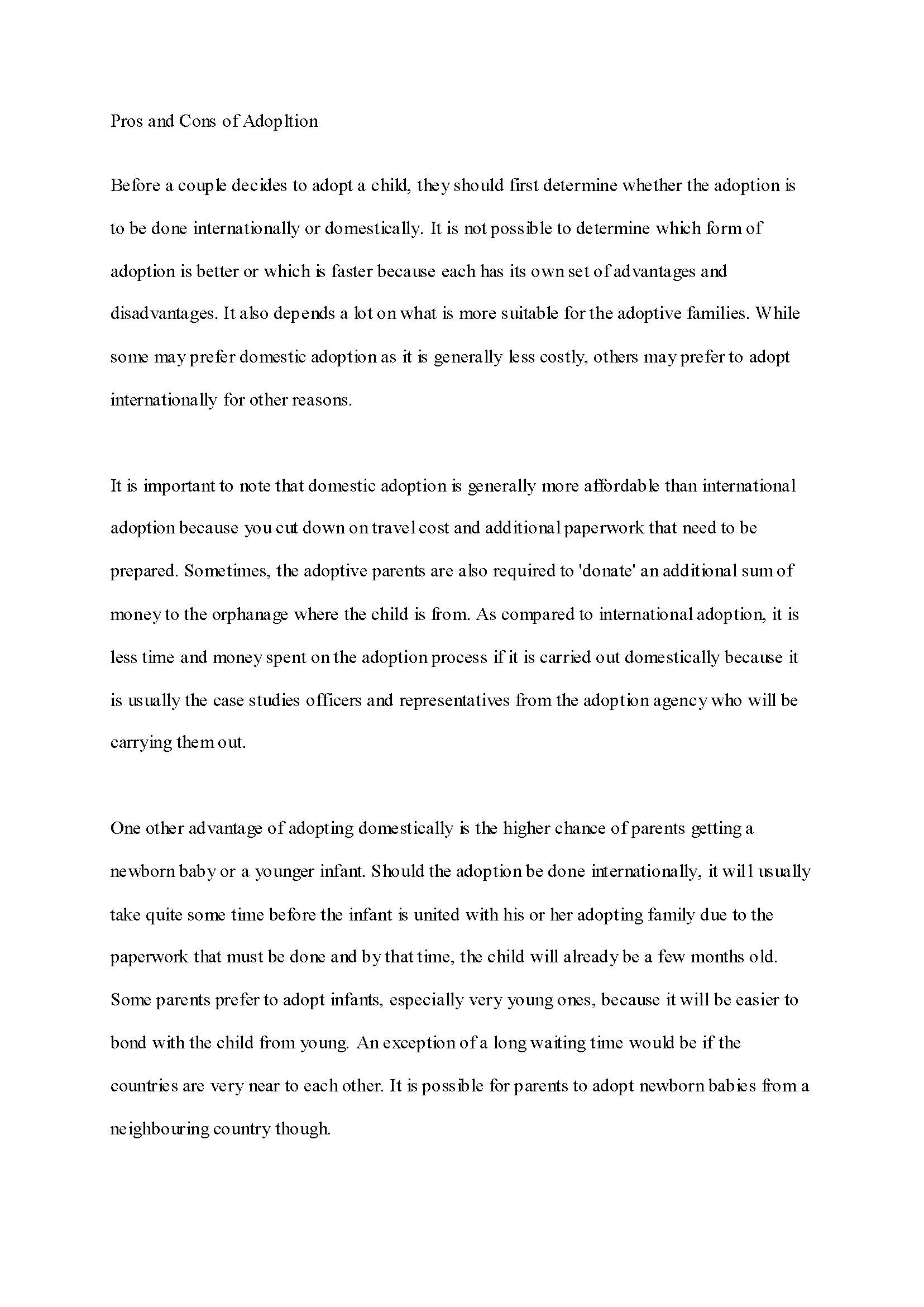
Size: 342 KB
Process Essay Example about Bathing Your Dog
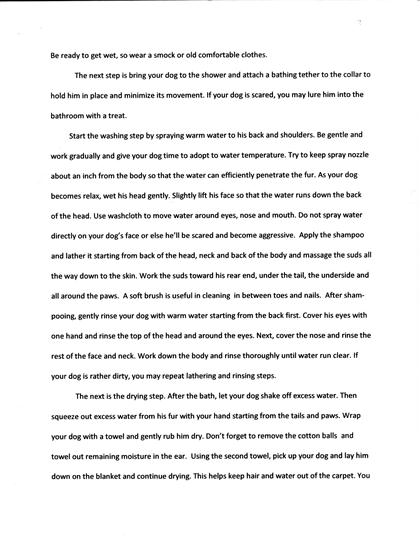
s3.amazonaws.com
Size: 45 KB
Basic Process Essay Example

Size: 756 KB
Writing Your Body Paragraphs
1. consult your outline.
People have the tendency to be sidetracked, especially when making their own stories or novels or any written work for their personal use or for their schoolwork. From time to time, it is best to try and consult with the outline that you have made as not to get lost and personally confused to where you currently are in your essay making process. As aforementioned, outlines are considered an excellent way to draft the flow of your speech or essay should you ever get lost somewhere in the middle of your essay writing. Always refer back to your bullet points if ever your point was not made somewhere in the body of the paragraph. The outline is not always right, it is merely temporary. The possibility of not following your outline might not actually exist if you have happened to draft a better one. For more ways to help start up your essay , you may refer to this hyperlink.
Try to be very careful with items that consist of multiple steps. Make the transitions clear enough and acknowledge prior steps regarding a particular item, if at all applicable.
2. Structure the body of the essay in paragraphs
The outline simply serves as the guide for your essay and is not really the speech itself. Since you have already given some thought into making the outline, now is high time to formulate the body of your essay. As much as possible, when you decide to do the initial draft of your essay, keep it in paragraph form. Bullet points may be simpler, but it is first and foremost an essay. For instance, if your process essay is about making the best shepherd’s pie, try drafting a paragraph on how to make the filling below and another paragraph on how to create good mashed potatoes on top of the lamb filling below. This, in turn, separates the two ideas for easy clarification.
Scholarship essays are normally written by applicants who wish to get their education at a lesser price, considering they uphold to the following conditions.
3. Add transitions in between steps
And since it is a process essay, it is very important that you place transitions on the steps to allow your readers to help identify as to what is Step 1 and what is Step 2. These transitions make it easier for the readers to help proceed to the next step without worrying they might have missed something on the previous step. Examples of some transitions would be the words next , first , later , then , finally , before , afterward , etc. For some examples of formal essays , you may refer to the hyperlink.
For instance, you could write, “Next, place the pot on the stove,” to move from one paragraph to the next.
4. Avoid using first-person pronouns
Including I , we , us , me , mine , our , and ours within your writing can make it seem less declarative and authoritative. In a process essay, this can make a reader less likely to trust your instructions. Instead, stick with a second and third-person perspective by using words, such as it or they . Here are some examples of argumentative essays for your reference.
For example, you could write, “This essay shows…” instead of “I’ll show.”
5. Mention any cautionary notes
Some people would normally forget to add that at the end of the process essay. This is perhaps one of the worst things that the author will not bother doing since he or she did not think that the reader will go to that extent of not following what was written. As someone who has written the process essay in the first place or a notable DIY star on YouTube, please mention some of the mistakes or actions that people tend to do when performing the said task. By doing so, you might actually save a life when you warn people beforehand. These cautionary notes serve as a warning to people as it might have already happened to some unfortunate people already. So when you are warned not to microwave your electronic devices for the sake of fun, just do not. For reference in writing personal essays , you can go through our website to find out more.
For example, you might caution a reader to “Cook the meat until it is no longer red in the center.” This advice will help them to avoid foodborne illness.
Process Essay Example about Hosting the Pre-Homecoming Dance Dinner
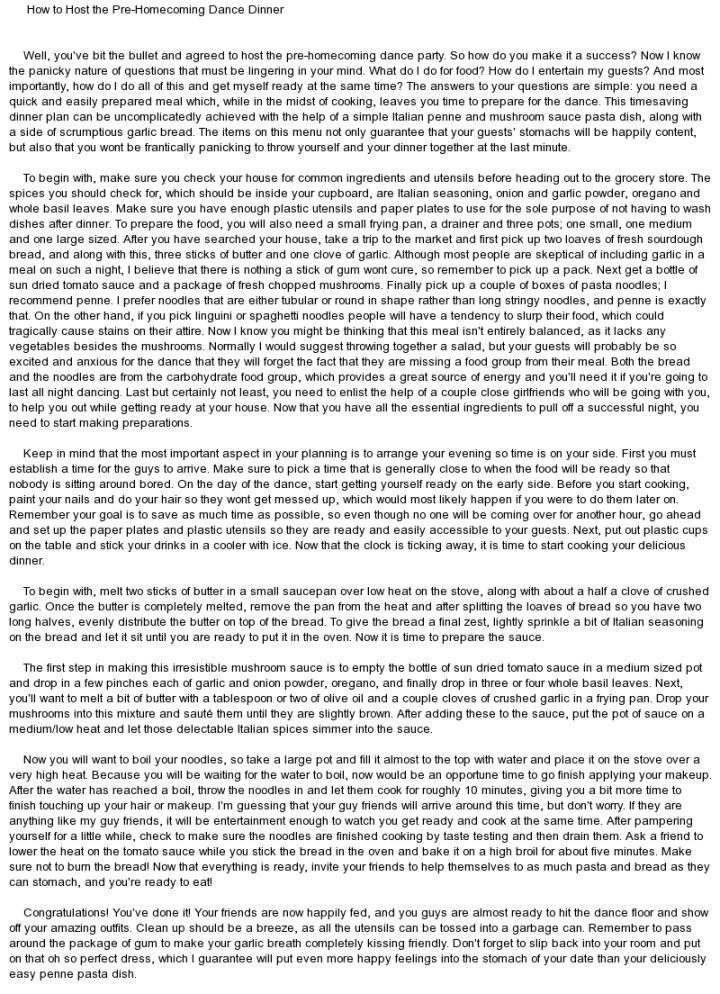
Size: 262 KB
Process Essay Writing Example
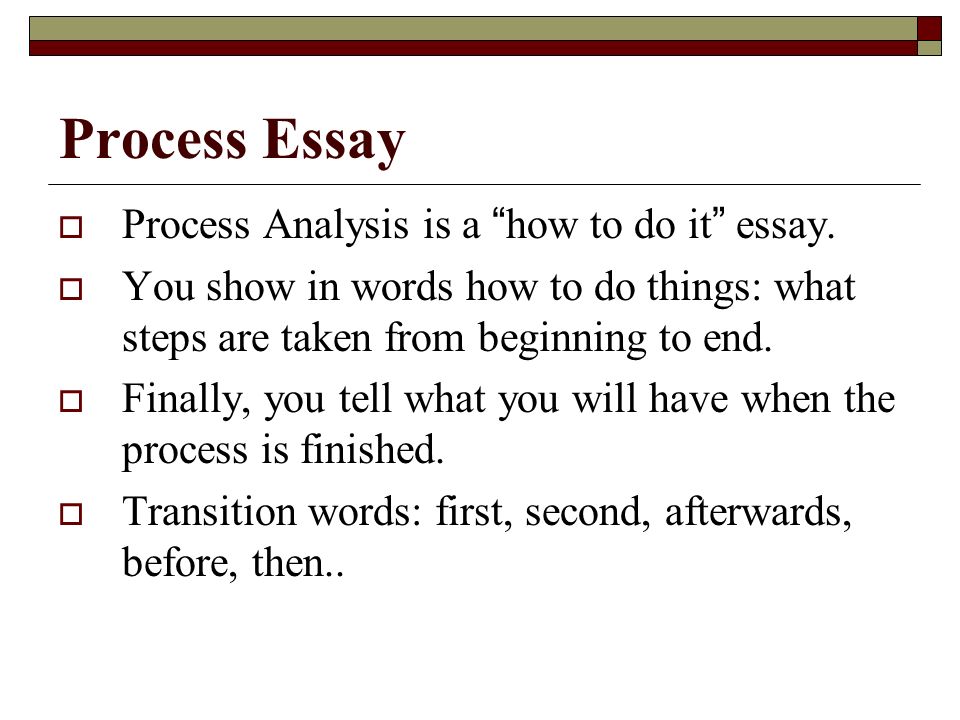
Size: 79 KB
Sample Outline of a Research Article
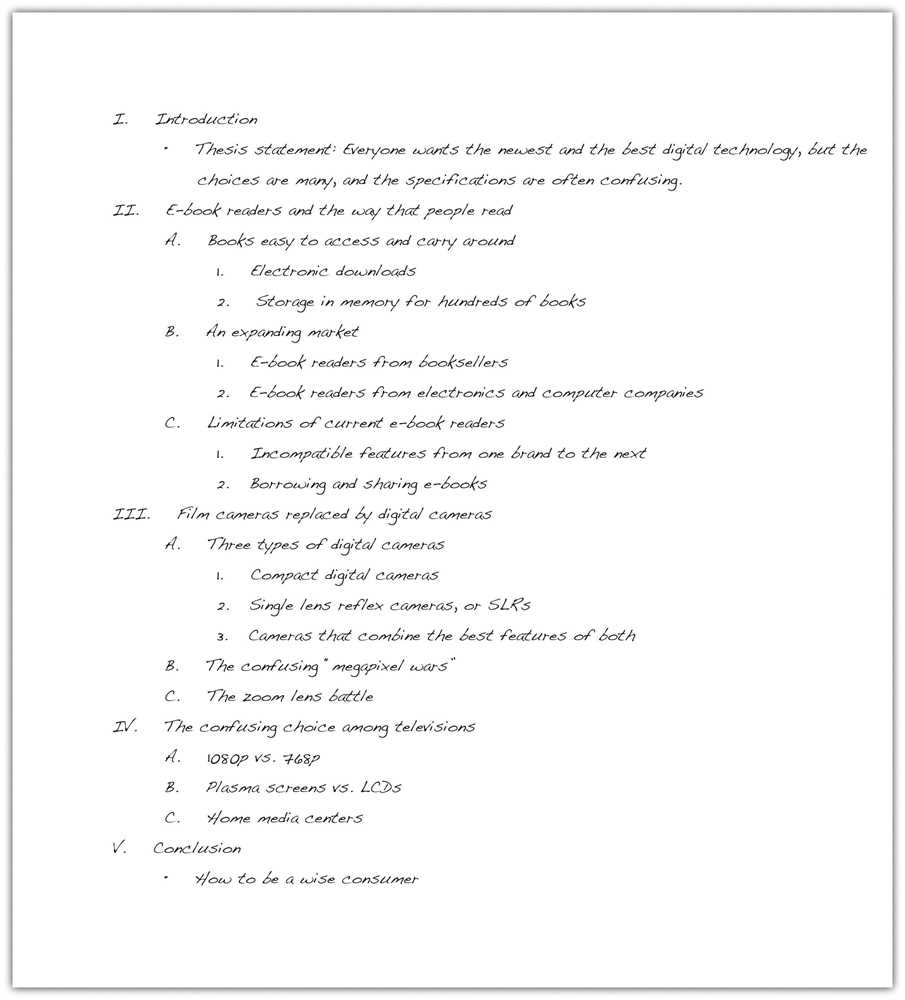
Size: 78 KB
Process Analysis Essay Writing Tips

Size: 95 KB
Odor Nuisances Sample Essay
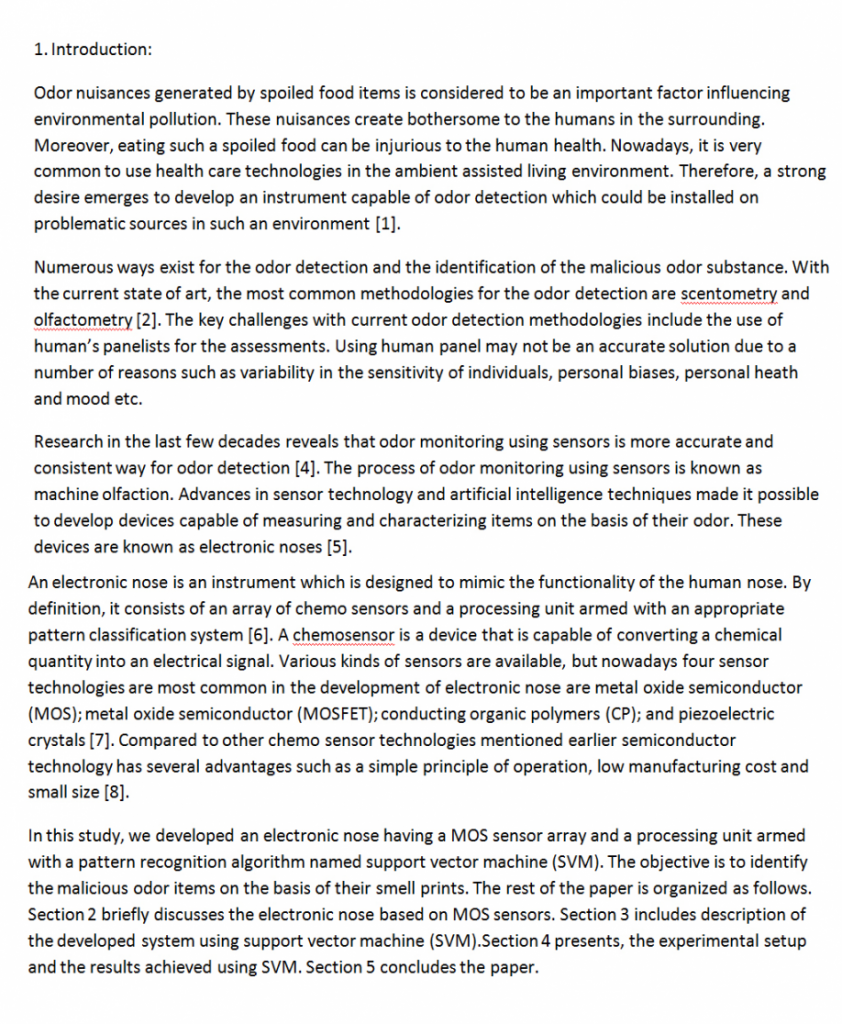
Size: 776 KB
The Process of Building Stonehenge Research Paper

Size: 241 KB
Wrapping It Up
1. Mention the end product and what to do with it. At the last few minutes of the DIY video or the process essay, you can see that you are almost through making the said product. Now, there are some people who might already have an idea of what to do with them. For example, let us say that you are done making the recipe for the coffee jelly dessert. You can provide suggestions as what to do with the coffee jelly that you have made (e.g., After cutting the coffee jelly into cubes, pour it into a tall glass and pour some cold-brewed coffee to give it that extra flavor. And finally, top it off with some ice cream and place a spoon or straw. Best served chilled with family and friends). Here are some tips and examples that you might need when writing a thesis statement for your narrative .
2. Restate the importance of the task. Cooking has proven itself to be quite a challenge, especially when one has no background or experience in cooking. It can otherwise be daunting, and there will be times that you will feel like passing out or giving up. But if you hold on to the very reason as to why you are doing it in the first place, it will keep you focused on completing the task at hand quicker than expected. To be quite fair and frank, this is often utilized by marketing stunts everywhere even in making DIY arts and crafts projects for Father’s Day and Mother’s Day. Here are some examples of persuasive essays that can serve as a reference when writing essays.
3. A basic example of a newly-made dinner intended for your parents’ anniversary might be, “And there you have it! A delicious yet quick meal fit for the two of them to enjoy which looks complicated and sophisticated but is actually simple enough with enough practice. Next time, experiment with different herbs and spices to find your own spin on this classic dish.”
4. Check your essay for ease of reading. Now that you are through writing your essay, the next best logical thing to do would be to actually take some time to review them. If you think you are satisfied with the flow of the essay that you have written, then you may publish it with ease. But if you do not think you are comfortable or assume that there is something lacking in the process essay, take the time to double-check the content and add the necessary content to the essay. While you are in the middle of double-checking, try adding a few final touches to your essay for it to sound better. Lend your essay to a friend or family member to check if they had understood the whole process. Here are some examples of academic essays .
5. One tip would be to see if there are certain steps that you can eliminate or condense your instructions as not to take up too much space in the essay. A reader is more likely to finish directions that they can easily skim through.
6. Proofread your essay. Finally, proofread your essay. Don’t rely on spell-check alone, as it cannot account for context and doesn’t catch every error. But other than spell-checking your essay, make sure to also check for typographical errors in terms of grammar and preposition, subject-verb agreement, etc. Keep in mind that people from all over will be reading your essay, so make sure that it is written professionally in whatever language you will be using. Here are some examples of high school essays that you can refer to.
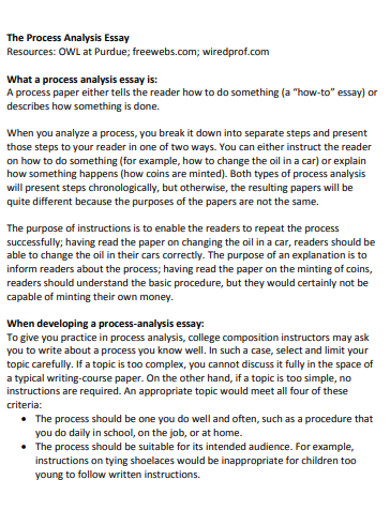
Size: 198 KB
Expository or Process Essay Example
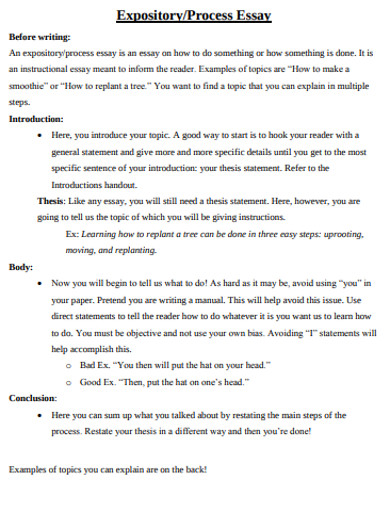
Size: 329 KB
Minimalist Process Essay Example
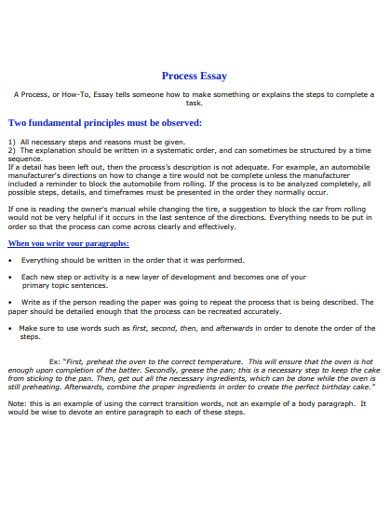
Size: 90 KB
Process Essay Example in PDF
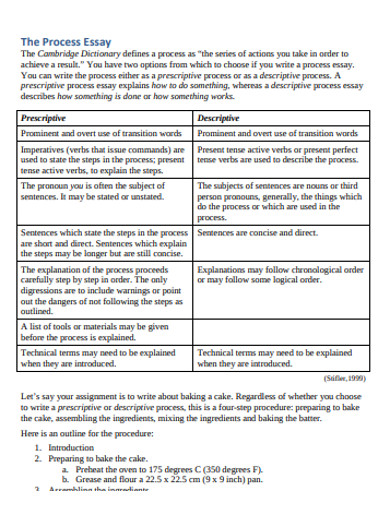
Size: 109 KB
Fundamental Process Essay Example

Size: 64 KB
Cheerleading Routine Process Essay Analysis Example
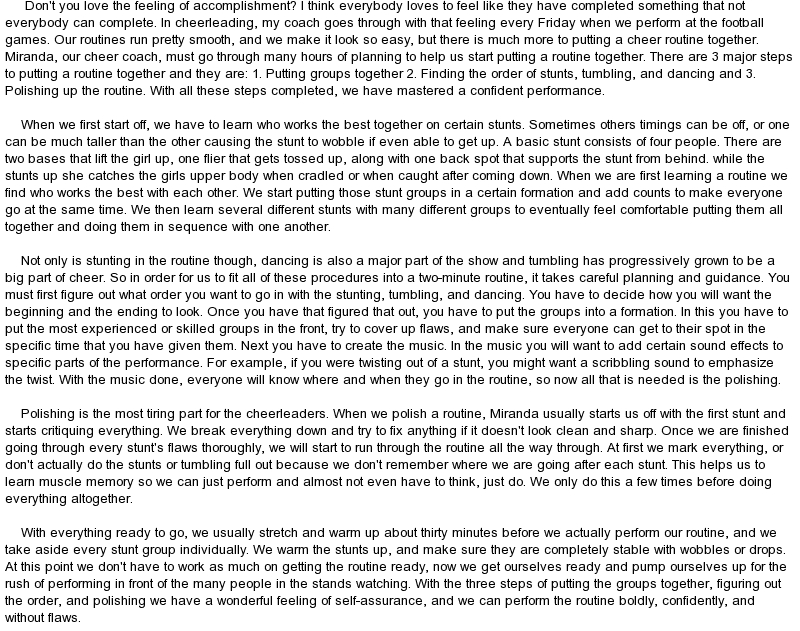
Size: 220 KB
Interesting Process Essay Ideas to Write in 2019
2019 is considered the “Year of the Earth Pig.” This could indicate laziness; however, it could also depict enthusiasm for some people. Considering that the usage of social media and the internet in this year is prevalent, people tend to view loads of various information that shape their own perspective. Moreover, this era strongly pushes the empowerment for every individual to showcase themselves, abling them to do what they want to do. Conclusively, the freedom of this age provides people a wide variety of interests.
A process essay explains the how-tos of a certain topic. Now that you already tackled the basics of this composition as well as the steps in making one, we are giving you in this section some exciting ideas that you can use in writing your own process essay for this year, 2019. According to your preference, you may consider selecting from these topics:
1. Technology-based ideas
2019 is a year that belongs to an era of rapidly innovating technology where gadgets and internet are major tools for almost everybody. Hence, it is not a surprise that people commonly ask some steps regarding technology. In writing your 2019 process essay, here are some examples of technology-based ideas:
- How to create your own Facebook account?
- How to reboot your phone?
- How to create your own Instagram account?
- How to upload several pictures on Facebook in 3 simple clicks?
- How to invite someone to play an online game?
- How to rank up in Mobile Legends?
- How to call someone via Messenger?
- How to use Snapchat as a newbie?
- Step-by-step guide in composing your first tweet
- How to perform a factory reset on your phone?
2. Smart aesthetic hack ideas
The presence of the internet also paved the way for beauty online influencers to showcase their own intelligent ideas. Consisted of mostly females, different channels and blogs fascinate their audience with their various mind-blowing hacks in grooming oneself. They also give some out-of-the-box solutions to the common aesthetic dilemmas. Basically, topics under this section range from fashion to beauty tips bonanza which include:
- How to transform a shirt into a skirt?
- How to rescue your shattered face powder?
- DIY T-shirt printing
- How to brush teeth the correct way?
- Alternative ways to curl hair
- How to make your own anime costume?
- How to make your own natural body scrub?
- How to do your full-face make-up in 3 easy steps?
- How to select the perfect sunglass for you?
- How to distinguish fake jewelry from genuine ones?
An important reminder, try to talk about processes that do not involve your audience’s health, especially if you are not a professional or your step is not yet widely studied.
3. Cooking hack ideas
Food is a basic necessity for each individual and just like the previous one, the internet also provided the cooking pros a medium to share their impressive easy-to-do recipes and strategies in preparing edibles. This extends from simple snacks and desserts to meals of rare occasions, turning simple white plates to something you can boast your friends of. These ideas may include:
- How to make a home-made chocolate fudge?
- Simple steps in making a no-bake cake
- How to slice onions the correct way?
- Impressive ways to plate your meal
- Easy-to-make soup recipes
- How to brine a turkey?
- How to make the perfect sandwich for your kids?
- How to boil eggs perfectly?
- How to remove avocado seed fast?
- Step-by-step guide in assembling cake layers
Process Essay Generator
Text prompt
- Instructive
- Professional
Write a Process Essay on how to prepare for a high school exam.
Discuss the steps involved in writing a research paper for your Process Essay.
Writing a Process Analysis in Six Steps
This essay about mastering the craft of process analysis essays outlines six essential steps for crafting a clear and precise narrative. From selecting a relevant topic to refining the final draft, it guides students through the intricacies of composing an effective essay. Each step emphasizes clarity, structure, and meticulous research, culminating in a polished narrative that enlightens and engages readers.
How it works
As an avid scholar committed to academic brilliance, honing the skill of composing a process analysis essay stands as a pivotal endeavor. Whether tasked with elucidating the intricacies of brewing the perfect cup of coffee, troubleshooting a perplexing software glitch, or executing a scientific experiment flawlessly, the ability to articulate a series of steps with clarity and precision holds utmost significance. In this compendium, we embark on an expedition through the labyrinth of composing an impeccable process analysis essay in six comprehensive steps, ensuring that your narrative not only enlightens but also enraptures the reader in its structured elegance.
Step 1: Picking the Pristine Topic
The cornerstone of any exemplary process analysis essay lies in the astute selection of a topic. It is prudent to opt for a subject matter that resonates with your expertise or holds personal significance. This could range from a cherished pastime to a skill you’ve mastered or even a procedure you’re passionate about unraveling. Moreover, the chosen topic must resonate with your audience, ensuring relevance and engagement. Remember, the objective transcends mere instruction; it’s about fostering intrigue and connection.
Step 2: Deciphering the Audience’s Perspective
Before embarking on the voyage of composition, it’s imperative to decipher the vantage point of your audience. Gauge their familiarity with the subject matter and tailor your elucidations accordingly. Strive for lucidity sans the labyrinthine jargon, unless your audience boasts a penchant for technical intricacies. The goal is to elucidate, not obfuscate. Thus, tailor your exposition to resonate with the audience’s comprehension level, ensuring accessibility and engagement.
Step 3: Delving into Diligent Research
A robust edifice of research serves as the cornerstone of a well-rounded process analysis essay. Dive into the depths of scholarly repositories, peruse academic tomes, and scour reputable sources to amass a reservoir of knowledge. Consider supplementing this endeavor with interviews of subject matter experts or individuals well-versed in the process at hand. The quest for understanding must be relentless, ensuring that each step is comprehended with utmost clarity and accuracy.
Step 4: Architecting a Seamless Structure
Armed with a trove of research, it’s time to architect a structure that embodies coherence and fluidity. Outline the sequential steps of the process, ensuring a seamless transition from one to the next. Employ enumeration or bullet points to delineate each step, facilitating ease of comprehension. Visual aids such as diagrams or illustrations can serve as beacons of elucidation, guiding the reader through the labyrinth of complexity. A meticulously crafted outline lays the groundwork for a narrative imbued with clarity and structure.
Step 5: Weaving the Tapestry of Expression
The zenith of the endeavor lies in transmuting the raw data into a narrative that beckons with clarity and allure. Commence with a robust introduction, a gateway that beckons the reader into the realm of elucidation. Provide a succinct overview of the process, setting the stage for the journey that unfolds. Each subsequent paragraph must unfurl with precision, elucidating each step with meticulous detail. Eschew verbosity in favor of succinctness, ensuring that each word serves a purpose in the tapestry of expression. Transition between steps with finesse, maintaining the cadence of comprehension.
Step 6: Refining the Opus
The denouement of the odyssey entails refining the opus to its apotheosis. Embrace the mantle of the discerning critic, scrutinizing every facet of the narrative with meticulous precision. Pay heed to coherence, clarity, and grammatical finesse, ensuring that the narrative flows with seamless elegance. Solicit feedback from peers or mentors, garnering insights that illuminate avenues for improvement. Revise ardently, incorporating enhancements that elevate the opus to its zenith. Remember, the pursuit of perfection is a ceaseless endeavor, but it is in this pursuit that mastery is attained.
In denouement, the art of composing a process analysis essay is an alchemy of intellect, diligence, and expression. By traversing these six steps with assiduous dedication, you embark on a voyage that transcends mere instruction, forging a narrative that enlightens, captivates, and resonates with enduring allure. So, arm yourself with parchment and quill, and embark on the odyssey that leads to mastery. In the symphony of expression, let your voice resonate with clarity and elegance, for it is through this symphony that the quintessence of brilliance is attained.
Cite this page
Writing A Process Analysis In Six Steps. (2024, Apr 14). Retrieved from https://papersowl.com/examples/writing-a-process-analysis-in-six-steps/
"Writing A Process Analysis In Six Steps." PapersOwl.com , 14 Apr 2024, https://papersowl.com/examples/writing-a-process-analysis-in-six-steps/
PapersOwl.com. (2024). Writing A Process Analysis In Six Steps . [Online]. Available at: https://papersowl.com/examples/writing-a-process-analysis-in-six-steps/ [Accessed: 19 Apr. 2024]
"Writing A Process Analysis In Six Steps." PapersOwl.com, Apr 14, 2024. Accessed April 19, 2024. https://papersowl.com/examples/writing-a-process-analysis-in-six-steps/
"Writing A Process Analysis In Six Steps," PapersOwl.com , 14-Apr-2024. [Online]. Available: https://papersowl.com/examples/writing-a-process-analysis-in-six-steps/. [Accessed: 19-Apr-2024]
PapersOwl.com. (2024). Writing A Process Analysis In Six Steps . [Online]. Available at: https://papersowl.com/examples/writing-a-process-analysis-in-six-steps/ [Accessed: 19-Apr-2024]
Don't let plagiarism ruin your grade
Hire a writer to get a unique paper crafted to your needs.

Our writers will help you fix any mistakes and get an A+!
Please check your inbox.
You can order an original essay written according to your instructions.
Trusted by over 1 million students worldwide
1. Tell Us Your Requirements
2. Pick your perfect writer
3. Get Your Paper and Pay
Hi! I'm Amy, your personal assistant!
Don't know where to start? Give me your paper requirements and I connect you to an academic expert.
short deadlines
100% Plagiarism-Free
Certified writers
How to Write a Process Analysis Essay: Examples & Outline
Process analysis is an explanation of how something works or happens. Want to know more? Read the following article prepared by our custom writing specialists and learn about:
Our specialists will write a custom essay specially for you!
- process analysis and its types
- a process analysis outline tips
- free examples and other tips that might be helpful for your college assignment
So, let’s start digging deeper into this topic!
- ♻ Process Analysis Definition
- ✏️ Process Analysis Types
☑️ How to Write a Process Analysis Essay
- 📑 Examples & Bonus Tips
♻️ What Is Process Analysis?
A process analysis describes and explains the succession of actions, points out a specific result, and provides a detailed plan.
To be more precise, process analysis is targeted at explaining:
- how things work;
- how to do or make something;
- how something operates or happens.
So, if you want to know how an aircraft flies or how to start a business, you need to deal with process analyses that detail these procedures. You might be asking yourself: Are these two processes similar to each other? In fact, they are different. Moreover, there exist other types of processes. That’s why we have united some basic types into categories for your convenience.

Let’s get into the details.
Just in 1 hour! We will write you a plagiarism-free paper in hardly more than 1 hour
- Processes that are either related to people or performed by them, such as relationships, psychological aspects, or some manuals. These include descriptions of how to overcome depression, work in a team, or change the oil in your car.
- Processes that take place within a society. For example, it can be a description of the electoral process or how the judicial system works.
- Processes that occur in nature. It may be an explanation of cell division, the process of season change, or the life cycle of an organism. Process analysis plays a crucial role in scientific research. It helps to describe complex mechanisms and procedures, leading to advancements in science.
- Processes that are performed by machines. It can be an explanation of how a car engine works or how a helicopter flies.
- documenting knowledge;
- analyzing some separate actions;
- finding problematic issues;
- identifying the options for further improvements.
As you can see, some of these processes just need to be described , while others should be explained . There is a considerable difference between a description and an analysis. If you want to find it out, read the following part of this article.
✏️ Two Types of Process Analysis
As you already know, a process can be either described or explained. Following this, the two types of process analysis are:
- Directive process analysis: a description of a process.
- Informational process analysis: an explanation of how something works.
The primary difference concerns the purpose of these analyses. Now, let’s go into details.
Directive Process Analysis: Examples & Definition
Directive process analysis (also called prescriptive) answers the question of how to do or make something . In other words, it serves as an outline of specific steps a person should take to achieve the desired result. For example, it may be a description of how to plan a party or write a particular essay type (like this article.)
This type of process analysis is used in tutorials, manuals, or policy guides. In most cases, technicians and decision-makers utilize it.
Receive a plagiarism-free paper tailored to your instructions. Cut 20% off your first order!
Informational Process Analysis Essay: Examples & Definition
In contrast, an informational process analysis (also called explanatory or descriptive) demonstrates how something works or is done . To be more precise, it presents information about the way some things or phenomena function. For example, it can describe how a disease affects our bodies.
A descriptive analysis consists of two parts:
- data gathering;
- identifying casual relationships.
This combination helps find out the essence of the process.
An informational process analysis may be found in essays, magazine or newspaper articles, or videos. Mostly, students, researchers, or just curious people are interested in this type.
We have talked about the process analysis definition and types. Now, it’s time to find out about a process analysis essay and how to write it correctly. In this section, you will find lots of interesting and helpful information on how to write each part of the essay, some tips on topics selection, and examples.
Get an originally-written paper according to your instructions!
Process Analysis Essay Outline
Let’s start with the essay structure. Keep in mind that a process analysis should be written in chronological order. If you want your readers to understand the presented process clearly, divide it into stages and then into steps. It will make your essay more coherent.
A process paper outline consists of 4 parts. Here they are:

Process Analysis Essay Topics: How to Choose
Choosing a topic may seem confusing. You have many things you want to talk about, and you simply can’t decide. Sounds familiar? Don’t worry; these tips will help determine what process analysis essay topic to choose.
To select a topic, you need to:
- Analyze your interests and hobbies;
- Choose a process related to your interests;
- Look for something you are familiar with and don’t need any further research;
To sum it up, write about something you like and know about.
How to Start a Process Analysis Essay
You’ve chosen the topic but don’t know how to start writing about it? Don’t worry; we’ve collected the most effective strategies to help you create an excellent introduction.
It’s worth mentioning that your introductory part depends on the type of your process analysis. If it’s a directive essay, you need to explain the process to your readers. If it’s an informational essay, you describe the process.
STEP #1: Start with a definition . It’s necessary to mention the purpose and importance of your paper. The audience should have a meaningful reason for reading your essay.
Writing a perfect essay is easier than you think (directive.)
Stress is one of the reasons for health problems (informational.)
STEP #2: Add some background information . Expand on the details and define the process.
Baking requires particular skills and time. However, if you do everything correctly, you will get an excellent cake (directive.)
Constant stress exposure leads to the development of various health disorders, resulting in complex treatment (informational).
STEP #3: End your introduction with a thesis statement . Present the steps or stages of the process in one sentence.
To write a perfect essay, one needs to search for information from different sources, analyze the gathered data, and organize the ideas into a coherent text (directive.)
Chronic stress leads to the rise of blood pressure, the release of histamine, and a change of insulin level (informational.)
Just follow these steps to make sure you included all the necessary aspects in your introduction.
Process Analysis Thesis Examples and Tips
A thesis statement is a roadmap of your essay. That’s why it’s important to make it an effective one. Here’s what to keep in mind when writing a powerful thesis.
- Its content. It should contain all the essential information on your topic. A thesis is like a presentation of your paper in one sentence. That’s why you need to be clear and concise. Each of the aspects mentioned in a thesis should be expanded in a body paragraph.
Baking a pie is a simple process as all you need to do is to mix all the products, prepare the filling, and bake the combined ingredients in the oven.
When you see such a thesis, you understand that the paper will be about baking a pie rather than changing a tire.
- The number of parts. In fact, a process analysis thesis consists of two parts: the main point and the organizational format. The first element focuses on the purpose of the thesis. It’s worth mentioning that the content of the second part depends on the type of your process analysis essay.
- Its place in the text. Your thesis should be situated at the end of your introduction. To be more precise, it’s the last sentence of this part. In such a way, our audience will get a hint about the content of the following body paragraphs.
Feel free to check out the additional tips below. They will make your thesis perfect.
- Make it an affirmative sentence . Don’t write your thesis in the form of a question. This statement should be the answer to the question of the audience.
- Try to make it emphatic . Don’t start your thesis with trite phrases such as “this essay will explain,” “I will inform you about,” or “I will describe.”
- Add more aspects if necessary. For example, the thesis may state the inefficiency or unfairness of the process in question.
Process Analysis: Paragraphs for the Main Body
Similar to a thesis statement, the content and structure of the main body depend on your essay type. We have prepared several useful strategies for both types.
Informational Process Analysis: Body Paragraphs
Directive process analysis: body paragraphs, transition words for process essay & examples.
Each process has a beginning, a middle part, and an ending. To present a process analysis, divide it into meaningful parts and organize them properly. The readers should always have a clear understanding of a succession of actions.
That’s why you need to use transitional words. They can help the readers follow the text. We have prepared a list of transition words with some examples. Check it out below.
Process Essay Conclusion Writing Strategies
Finally, we get to the concluding part and how it should be arranged. Here are some helpful strategies for you to write an effective conclusion.
- Briefly summarize all the information you mentioned in your body paragraphs.
- Don’t introduce any new details. This part intends to conclude the essay.
- Paraphrase your thesis statement.
- Relate your conclusion with the introduction. There should be a logical ending for your essay. Sum up the information presented in all the parts of your paper.
To conclude, stress produces a negative effect on health. That’s why you should do something to reduce its impact. Include meditation and yoga in your daily routine. Don’t forget to have enough sleep. If you follow all these recommendations, your mental and physical health will improve very soon.
📑 Process Paragraphs Examples & Bonus Tips
We have already composed the process analysis essay. Now you know what to include and what to pay attention to while writing such a type of essay. However, we would like to share a list of some additional tips with you. They will help you to look at your paper from different angles and make it perfect.
Bonus tips:
- Consider the tone of your writing. Try to sound as professional as possible.
- Don’t forget about the formal style. Avoid writing in 1 st person. Instead, use the 2nd person in directive and the 3rd person in informational process analyses:
- You can interrupt the chronology of your process description. Sometimes, it’s essential to specify the terms or concepts, show how the preceding and following steps are connected, or clarify why it’s necessary to do some steps simultaneously.
- Give your readers a specific reason to care about your essay. Before writing your thesis statement, ask yourself: Why do people need to know about this process? The thesis should reflect the answer to this question.
Finally, we would like to present you with a process analysis essay example. Pay attention to the contents of each essay part:
Below, you can find even more process analysis essay samples. Make sure to check them out to get some inspiration for your paper.
- A Medical Committee’s Group Process Analysis
- How to Groom Your Pet Dog: Process Analysis
- Agency Supervisory Process Analysis
- Passing a Test: Process Analysis
Process Analysis Essay Topics
- Analysis of engineering process.
- Steps to successful aging .
- Analysis of quality improvement process .
- The process of data analysis .
- How to lose weight .
- Process of selecting a suitable theory or model in health intervention.
- The important steps of images processing.
- Strategic planning process analysis: stakeholders and initial agreement guidelines.
- How to write: process analysis.
- Steps for maintaining your mental health during pandemic.
- Process for financial accounting cycle .
- Steps for creating a realistic buyer persona .
- How to make a final decision .
- Stages of problem-solving strategy .
- The risk management in healthcare : process analysis.
- How to organize a group : stages.
- Describe the contingency planning process.
- Steps to planning a career .
- Enhancing wireless network performance : process analysis.
- How to cope with grief: five stages theory .
- Process for conflict resolving .
- How to analyze a primary source .
- Communication problems at workplace : stages analysis.
- How to conduct sociological research .
- Process of prenatal development : main stages.
- Stages of developing a new product .
- Clear steps to conducting community-based research .
- Making a dental public health policy : process analysis.
- Conducting a utility test : process analysis.
- The key steps to facilitate parent participation process.
- The implementation plan for treating patients with cancer.
- Discuss the steps of buying a product .
- Describe the process of business development .
- Analyze the brewery process .
- Cognitive development of children: process analysis.
- Describe the stages of different types of interviews .
- Analyze the process of employees’ talents development .
- How to buy a used motorcycle .
- Steps to making ethical decision .
- Analyze the ways of managing s diverse international team .
- Process analysis for proper teeth cleaning .
- Describe the steps of project management .
- Four stages of business development .
- How to cope with distress in nursing.
- External auditing process analysis.
- Analyze the stages of Alzheimer’s disease .
We hope you find our article useful and apply these strategies to your process analysis essay. We wish you success with all your future assignments.
Further reading:
- Case Study Analysis: Examples + How-to Guide & Writing Tips
- How to Write a Visual Analysis Essay: Examples & Template
- How to Write a Film Analysis Essay: Examples, Outline, & Tips
- How to Write a Literary Analysis Essay Step by Step
🔍 References
- Process Analysis: The University of Toledo
- Business Process Analysis: UNICE
- Process Analysis: University of Minnesota Twin Cities
- Informative Process Analysis: Saint Leo University
- How to Write a Thesis for Process Analysis Essay: Seattle PI
- Informative Process Analysis: Southern Illinois University Edwardsville
- Introductions and Conclusions: University of Toronto
- Process Description: How to Write about a Sequence of Events: Seton Hill University
- Essay Introductions: University of Maryland
- Essay Structure: Harvard University
- Share to Facebook
- Share to Twitter
- Share to LinkedIn
- Share to email

Want to know how to write a reflection paper for college or school? To do that, you need to connect your personal experiences with theoretical knowledge. Usually, students are asked to reflect on a documentary, a text, or their experience. Sometimes one needs to write a paper about a lesson...

A character analysis is an examination of the personalities and actions of protagonists and antagonists that make up a story. It discusses their role in the story, evaluates their traits, and looks at their conflicts and experiences. You might need to write this assignment in school or college. Like any...
![how to write a process essay example Critical Writing: Examples & Brilliant Tips [2024]](https://custom-writing.org/blog/wp-content/uploads/2021/02/fingers-note-report-journalist-filling-284x153.jpg)
Any critique is nothing more than critical analysis, and the word “analysis” does not have a negative meaning. Critical writing relies on objective evaluations of or a response to an author’s creation. As such, they can be either positive or negative, as the work deserves. To write a critique, you...

If you are assigned to write a rhetorical analysis essay, you have one significant advantage. You can choose a text from an almost infinite number of resources. The most important thing is that you analyze the statement addressed to an audience. The task of a rhetorical analysis essay is to...

Any literary analysis is a challenging task since literature includes many elements that can be interpreted differently. However, a stylistic analysis of all the figurative language the poets use may seem even harder. You may never realize what the author actually meant and how to comment on it! While analyzing...

As a student, you may be asked to write a book review. Unlike an argumentative essay, a book review is an opportunity to convey the central theme of a story while offering a new perspective on the author’s ideas. Knowing how to create a well-organized and coherent review, however, is...

The difference between an argumentative and persuasive essay isn’t always clear. If you’re struggling with either style for your next assignment, don’t worry. The following will clarify everything you need to know so you can write with confidence. First, we define the primary objectives of argumentative vs. persuasive writing. We...

You don’t need to be a nerd to understand the general idea behind cause and effect essays. Let’s see! If you skip a meal, you get hungry. And if you write an essay about it, your goal is achieved! However, following multiple rules of academic writing can be a tough...
![how to write a process essay example How to Write an Argumentative Essay: 101 Guide [+ Examples]](https://custom-writing.org/blog/wp-content/uploads/2021/01/young-writer-taking-notes-284x153.jpg)
An argumentative essay is a genre of academic writing that investigates different sides of a particular issue. Its central purpose is to inform the readers rather than expressively persuade them. Thus, it is crucial to differentiate between argumentative and persuasive essays. While composing an argumentative essay, the students have to...
![how to write a process essay example How to Title an Essay: Guide with Creative Examples [2024]](https://custom-writing.org/blog/wp-content/uploads/2021/01/close-up-woman-making-greeting-card-new-year-christmas-2021-friends-family-scrap-booking-diy-writing-letter-with-best-wishes-design-her-homemade-card-holidays-celebration-284x153.jpg)
It’s not a secret that the reader notices an essay title first. No catchy hook or colorful examples attract more attention from a quick glance. Composing a creative title for your essay is essential if you strive to succeed, as it: Thus, how you name your paper is of the...

The conclusion is the last paragraph in your paper that draws the ideas and reasoning together. However, its purpose does not end there. A definite essay conclusion accomplishes several goals: Therefore, a conclusion usually consists of: Our experts prepared this guide, where you will find great tips on how to...
![how to write a process essay example How to Write a Good Introduction: Examples & Tips [2024 Upd.]](https://custom-writing.org/blog/wp-content/uploads/2021/01/closeup-shot-woman-working-studying-from-home-with-red-coffee-cup-nearby-284x153.jpg)
A five-paragraph essay is one of the most common academic assignments a student may face. It has a well-defined structure: an introduction, three body paragraphs, and a conclusion. Writing an introduction can be the most challenging part of the entire piece. It aims to introduce the main ideas and present...

How to Write a Process Essay on Food

How to Write a Process Essay About Cupcakes
A process essay on food is either an essay that tells you how to make a recipe or one that tells you how a food product is made. Both essays are written in the form of step-by-step instructions. As you research and write your essay, you'll likely learn a lot, which can benefit you as the author, as baking brownies from scratch is time-consuming, but the final product is well worth the wait. It is important to keep your directions or process steps as simple as possible. If the process is a recipe, the article should teach the reader how to make it. If the process is how a certain food product was made, like name-brand factory products, the reader should understand all the steps that went into creating that food product.
Writing About How Food is Made
Find out everything there is to know about making the food product about which you are writing. Take notes, use legitimate sources and if possible, interview someone directly involved in the production of the food product. Consider all of the ingredients, staff and machinery necessary to make the food you are learning about. You may be writing about how a factory mass produces their brand of food, such as candy bars or toaster pastries, or how a private bakery is run. Ask questions appropriate to your topic.
Before you begin writing, first outline your essay. This will help plan everything you want to write about. Order everything in sequential order, so the reader will clearly understand how the food product is made. Next, write the body of your essay. Each paragraph should be one point or one step in the process to make the food product. Make sure the reader knows everything involved in the process you are writing about.
Finally, write the introduction and conclusion of your essay. It is best to write the introduction after the body, so you understand what you are introducing. An introduction should prepare a reader for your article and possibly give them some background information on the process. The conclusion should summarize all of your main points. Last but not least, go back over your essay and correct any grammatical or spelling errors.
Writing Recipes
Learn everything you can about the recipe you are writing about. Do some research and learn if there are different ways to make the food in the recipe. Make sure you are educated in the cooking methods required in the recipe. It's also important to cook or prepare the recipe yourself. When you have followed the steps you learned, you will understand how best to teach those steps to others, and you might pick up some new cooking skills as well.
Next, write down all of the steps to prepare the recipe. Be sure to write the recipe in chronological order. For example, for recipes that require baking, mention preheating the oven first, so it can be at the proper temperature when it's time to place your dish in the oven. Include a list of necessary ingredients.
Then, you'll be able to write an introduction to the essay. This is best done after you have written the steps, so you know exactly what you are introducing. Try to include background information on the recipe in question.
Finally, write a conclusion to the essay. In this section include any variations to the recipe. If certain ingredients can be exchanged for others, let the reader know. Also, don't forget to proofread your essay at least one more time for spelling and grammatical errors, and fix if necessary.
Related Articles

How to Donate Plasma for Money in North Carolina

How to Donate Your Body to Science for Money

How to Stay on Topic When Writing an Essay

How to Create an Animal School Project
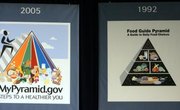
How to Make Food Pyramids for a School Project

How to Write an Essay on Transportation Problems

Informative Writing Techniques

How to Write High School Research Papers
- Excelsior Online Writing Lab: Essay Writing
- Edit your essay for spelling or grammatical errors.
Step-By-Step Guide on How To Write A Process Essay (W/ Essay Example)
Feb 8, 2024 | 0 comments

Feb 8, 2024 | Blog | 0 comments
Are you struggling with writing an effective process essay? Whether you’re a student needing help with an academic essay or just want to learn how to write a good process essay, understanding the writing process is essential. To effectively describe the process of completing a certain task, it’s important to know how to structure your essay in a way that flows logically and is easy for your audience to follow. In this step-by-step guide, we’ll show you how to write a process essay, complete with an essay example to help you understand the concept better. First, we’ll discuss the different types of process essays, such as the expository essay and the process analysis essay. Then, we’ll delve into the writing process, including how to create an outline, use transition words, and ensure your essay is in chronological order. By the end of this article, you’ll have the tools you need to start writing your process essay, no matter the subject.
People Also Read
- How to write a Spooky Essay on Halloween (With Example)
- How to Write a Diagnostic Essay: A Step-by-Step Guide (With Example)
- How to Structure an Informative Essay: A Step-by-Step Guide
What Is a Process Paper?
A process paper is a written guide that explains how to complete a certain task or achieve a specific goal. It provides detailed instructions and clear steps to follow to complete the process. Process papers are commonly used in a variety of fields including education, business, and technical industries. They are a valuable tool for providing clarity and guidance for individuals who may be unfamiliar with a particular process. By following the instructions laid out in a process paper, individuals can effectively accomplish their desired tasks or goals.
The difference between a Process Essay and a Process Analysis Essay
The main difference between a Process Essay and a Process Analysis Essay lies in the approach and focus. A Process Essay describes the process of how something is done or how something works, providing a step-by-step guide to the reader. It is often more general and can cover a wide range of topics. On the other hand, a Process Analysis Essay goes into much more detail and analysis, focusing on the specific steps and techniques involved in a particular process. It delves deeper into the intricacies of the process and aims to provide a thorough understanding of the topic at hand. Both essays aim to inform and educate, but they differ in the level of detail and analysis they provide.
Benefits of Writing a Process Essay
- Improves Explanation Skills: Writing a process essay requires breaking down a task or process step by step. By doing so, you become better at explaining complex concepts clearly and understandably. This skill can be impactful in various aspects of your life, from explaining instructions to others to clarifying procedures at work.
- Enhances Proofreading Abilities: Since process essays aim for clarity and conciseness, you’ll need to proofread your work meticulously. This practice helps you catch typos and grammar mistakes, ensuring your essay is error-free. Additionally, it teaches you to be careful with items that contain imperative sentences, ensuring they are precise and easy to follow.
- Strengthens Writing Skills: Writing a process essay follows the structure of an essay, including an introduction, body paragraphs, and a conclusion. Through this process, you refine your ability to organize your thoughts logically and cohesively. Each part of your essay must flow smoothly from one step to another, reinforcing the importance of structure in writing.
Process Essay Outline: Structuring Your Paper
How to Plan a Successful Party: A Step-by-Step Guide I. Introduction A. Explanation of what a party planning process essay is B. Importance of planning a successful party C. Overview of the steps to be covered in the essay II. Understanding the Party Planning Process A. Defining the purpose and type of party B. Setting a budget and determining the guest list C. Choosing a date, time, and location for the party III. Selecting a Theme and Décor A. Brainstorming theme ideas based on the occasion and preferences B. Selecting appropriate decorations, colors, and ambiance C. Planning for any specific decorations or props needed IV. Organizing Food and Drinks A. Planning the menu based on the theme and preferences of guests B. Creating a shopping list for ingredients and supplies C. Considering dietary restrictions and preferences of attendees V. Arranging Entertainment and Activities A. Deciding on music, games, or entertainment options B. Renting or purchasing any necessary equipment or supplies C. Planning for any special performances or activities VI. Sending Invitations and Confirmations A. Designing and sending out invitations with necessary details B. Following up with RSVPs and guest confirmations C. Providing directions or instructions for attending the party VII. Preparing the Venue and Setting Up A. Cleaning and decorating the party space B. Setting up tables, chairs, and other furniture as needed C. Arranging food and drink stations, entertainment areas, and seating arrangements VIII. Hosting the Party A. Welcoming guests and ensuring they feel comfortable B. Managing food and drink service throughout the event C. Facilitating entertainment and activities to keep guests engaged IX. Wrapping Up and Cleaning Up A. Thanking guests for attending and expressing gratitude B. Collecting feedback and suggestions for future parties C. Cleaning up the venue and disposing of any waste or leftover items X. Conclusion A. Recap of the key steps in planning a successful party B. Emphasis on the importance of thorough planning and attention to detail C. Encouragement to apply the process outlined for future party planning endeavors.
How to Write a Process Essay
Learning how to write a process essay is essential for effectively guiding readers through a series of steps to complete a task or understand a process. This comprehensive guide provides step-by-step instructions and practical tips to help you craft a clear, concise, and informative process essay.
Step 1: Understanding the Topic
Understanding the topic is the first crucial step in writing a process essay. Before diving into the writing process, you must have a clear grasp of the task or process you’re explaining. Here’s how to understand the topic effectively:
- Analyze the Assignment Prompt: Start by carefully reading the assignment prompt or guidelines. Pay attention to any specific instructions provided by your instructor regarding the topic, scope, and objectives of the process essay.
- Research and Gather Information: Conduct thorough research to gather information about the process you intend to explain. Utilize credible sources such as books, articles, websites, or personal experiences to gain a comprehensive understanding of the topic.
- Identify Key Steps and Components: Break down the process into its essential steps and components. Consider the chronological order of these steps and any additional details or variations that may be relevant to your audience.
- Consider the Audience Perspective: Put yourself in the shoes of your audience and consider what they already know about the topic. Tailor your explanations to their level of understanding and anticipate any questions or areas of confusion they may have.
- Clarify Ambiguous or Complex Concepts: If there are any ambiguous or complex aspects of the topic, take the time to clarify them. Use simple language and clear examples to ensure that your readers can follow along easily.
- Define Key Terms: Define any technical terms or jargon associated with the process to ensure clarity for your readers. Avoid assuming prior knowledge and provide explanations for terms that may be unfamiliar.
Process Essay Topics
- How to Bake a Perfect Chocolate Cake
- Planning a Budget-Friendly Vacation
- Organizing a Successful Garage Sale
- Crafting the Ideal Study Schedule
- Mastering Basic Cooking Techniques
- Building a DIY Birdhouse for Your Garden
- Creating a Personalized Workout Routine
- Growing Your Vegetable Garden
- Designing an Effective Resume for Job Applications
- Setting Up and Managing a Home Recycling System
- Establishing Healthy Sleep Habits for Better Rest
- Writing an Engaging Blog Post from Start to Finish
- Planning and Hosting a Memorable Movie Night
- Developing a Morning Routine for Productivity and Success
- Creating a Travel Itinerary for Your Dream Destination
Step 2: Crafting the Thesis Statement
Crafting a strong thesis statement is a crucial step in the process of writing a process essay. Your thesis statement serves as the roadmap for your essay, guiding readers on what to expect and helping you maintain focus throughout the writing process. Here’s how to tackle this step effectively:
- Importance of a Strong Thesis Statement: In a process essay, a robust thesis statement sets the tone and direction for the entire essay, providing clarity on the purpose and goal of the process being explained. It informs readers about the specific process they will learn about and why it is significant. Without a clear thesis statement, your essay may lack direction, leaving readers confused about the purpose of the essay and the steps involved in the process. A strong thesis statement ensures that your essay remains focused and cohesive, guiding readers through each step of the process with clarity and purpose.
- How to Formulate a Clear and Specific Thesis Statement: Start by identifying the main goal or objective of the process you are explaining. What is the result or outcome that readers should expect to achieve by following the process? Next, clearly state the specific process or task that your essay will explain. Be concise and specific, avoiding vague language or broad statements. Your thesis statement should clearly outline the steps involved in the process without providing unnecessary details. Lastly, consider the audience’s perspective and tailor your thesis statement to their level of understanding. Use language that is accessible and easy to follow, ensuring that readers know exactly what to expect from your essay.
Step 3: Drafting the Introduction
Drafting an engaging introduction is essential in capturing the reader’s attention and setting the stage for your process essay. Here’s how to approach this step effectively:
- Hooking the Reader’s Attention: Begin your introduction with an attention-grabbing hook that piques the reader’s curiosity and encourages them to continue reading. This could be a compelling question, an intriguing fact, a relevant anecdote, or a thought-provoking quote. The goal is to draw readers in and make them eager to learn more about the process you’ll be explaining in the essay. By sparking their interest from the outset, you set a positive tone for the rest of the essay.
- Introducing the Process to be Explained: After hooking the reader’s attention, provide a brief overview of the process that will be the focus of your essay. Clearly state what the process entails and why it is important or relevant. Keep this introduction concise and to the point, giving readers a clear understanding of what they can expect to learn from the essay. Avoid delving into too much detail at this stage, as that will be covered in the body paragraphs.
- Providing Some Background Information on the Process: Depending on the complexity of the process and the knowledge level of your audience, it may be helpful to provide some background information or context to help readers better understand the significance of the process. This background information should be brief and relevant, offering insights into why the process is important or how it fits into a larger context. However, be mindful not to overwhelm readers with unnecessary details at this stage. By hooking the reader’s attention, introducing the process, and providing some background information, your introduction sets the stage for the rest of the essay, laying the groundwork for a clear and engaging exploration of the process at hand.
Step 4: Writing the Body Paragraphs
Writing the body paragraphs is the core of your process essay, where you’ll provide detailed instructions for each step of the process. Here’s how to approach this step effectively:
- Organizing the Steps of the Process in a Logical Order: Begin by organizing the steps of the process in a logical and sequential order. Consider the natural progression of the process and arrange the steps accordingly. Each step should build upon the previous one, leading readers through the process clearly and systematically. Avoid jumping around or presenting steps out of order, as this can confuse readers.
- Using Transitional Words and Phrases to Guide the Reader Through the Process: Use transitional words and phrases to smoothly transition from one step to the next. Words like “first,” “next,” “then,” and “finally” can help signal the progression of the process. These transitions act as signposts for readers, guiding them through each step and helping them understand how the steps are connected.
- Including Clear and Detailed Explanations for Each Step: Provide clear and detailed explanations for each step of the process, ensuring that readers understand exactly what needs to be done at each stage. Use simple language, avoiding unnecessary jargon or technical terms that may confuse readers. Break down each step into manageable chunks and explain each part thoroughly.
- Integrating Visuals or Illustrations to Enhance Understanding (if applicable): If appropriate, consider including visuals or illustrations to complement your written instructions and enhance understanding. Visual aids such as diagrams, charts, or photographs can provide additional clarity and help readers visualize the steps of the process more effectively. Be sure to integrate visuals seamlessly into your essay and provide clear captions or explanations to accompany them.
Step 5: Creating the Conclusion
Creating a strong conclusion is essential for wrapping up your process essay effectively and leaving a lasting impression on your readers. Here’s how to approach this step:
- Reinforcing the Significance of the Process: Begin by reinforcing the significance of the process you’ve explained in your essay. Remind readers why the process is important or relevant, emphasizing its impact or benefits. This helps to underscore the value of the information they’ve gained from reading your essay and reinforces the importance of understanding and mastering the process.
- Summarizing the Key Points of the Essay: Next, summarize the key points of your essay, briefly revisiting each step of the process and highlighting its significance. Keep this summary concise and focused, providing a quick overview of the main ideas without delving into unnecessary detail. By summarizing the key points, you help reinforce the main takeaways of your essay and ensure that readers have a clear understanding of the process you’ve explained.
- Offering Final Thoughts or Potential Outcomes of the Process: Finally, offer some final thoughts or reflections on the process. Consider discussing potential outcomes or results that readers can expect if they follow the process successfully. B. You might also offer suggestions for further exploration or experimentation with the process, encouraging readers to apply what they’ve learned in their own lives or endeavors. By offering final thoughts or outcomes, you provide closure to your essay and leave readers with a sense of satisfaction and direction moving forward.
Step 6: Revising and Editing
Revising and editing your process essay is a critical step in ensuring its clarity, coherence, and overall effectiveness. Here’s how to approach this step:
- Reviewing the Essay for Clarity and Coherence: Start by reviewing your essay from start to finish, focusing on its overall clarity and coherence. Check that each step of the process is explained in a logical and easy-to-follow manner. Pay attention to the flow of your essay, ensuring that each section transitions smoothly into the next. Make any necessary revisions to improve the organization and coherence of your essay.
- Checking for Grammatical, Spelling, and Punctuation Errors: Next, carefully check your essay for grammatical, spelling, and punctuation errors. Look for common mistakes such as incorrect verb tense, subject-verb agreement errors, misspelled words, and misplaced punctuation. Proofread your essay multiple times, reading it aloud if necessary to catch any errors that may have been overlooked. Use grammar and spell-check tools as additional aids in identifying and correcting mistakes.
- Seeking Feedback from Peers or Instructors: Consider seeking feedback from peers or instructors who can provide valuable insights and suggestions for improving your essay. Share your essay with them and ask for their honest feedback on its clarity, organization, and effectiveness. Be open to constructive criticism and use it as an opportunity to make further revisions and improvements to your essay. Consider incorporating any helpful suggestions or recommendations that are offered.
Essay Example: “How to Bake a Perfect Chocolate Cake”
Get help with your process essay paper.
Are you struggling with your process essay? Don’t worry! Essay Freelance Writers is here to help. We’re the best in the industry when it comes to essay writing services. Place your order today by clicking the ORDER NOW button above to get our expert assistance with your process essay writing. Whether it’s crafting a clear thesis statement or organizing the steps of your process, we’ve got you covered. Trust us to deliver high-quality, custom-written essays that meet your every need.
Frequently Asked Questions about Process Essay
What is a process essay.
A process essay is a type of writing that explains a step-by-step process of doing something. It aims to guide the reader through the actions required to complete the task .
How is a process essay different from other types of essays?
A process essay , also known as a how-to essay , focuses on the process of doing something and the parts of the process . Unlike other types of essays, it emphasizes the step-by-step process rather than simply presenting information or arguments.
What is the main body of a process essay?
The main body of a process essay should detail each step-by-step process necessary to complete the task. Each paragraph should focus on a certain process and serve as a guide for the reader.
Why is it important to pick something you know well when writing a process essay?
It is important to pick something you are familiar with when writing a process essay because it allows you to provide detailed and accurate instructions. Your knowledge of the subject will help in explaining the step-by-step process effectively.
What is the goal of a process essay?
The goal of a process essay is to explain the step-by-step process clearly and concisely. It should provide the reader with a complete understanding of how to complete the task .
What are some common mistakes to avoid when writing a process essay?
Some common mistakes to avoid when writing a process essay include using ambiguous language like “next ” or “then ” instead of providing specific instructions, and not considering the reader’s level of knowledge on the topic. It is also important to ensure that the words like “next and “now used are appropriate for the type of paper .

With a passion for helping students navigate their educational journey, I strive to create informative and relatable blog content. Whether it’s tackling exam stress, offering career guidance, or sharing effective study techniques

Most Popular Articles
Racism thesis statement example, how to rephrase a thesis statement, capstone project topic suggestions, how to write an abortion essay, should students wear school uniforms essay, list causal essay topics write, respect essay, signal words, great synonyms, informative speech examples, essay writing guide, introduction paragraph for an essay, argumentative essay writing, essay outline templates, write an autobiographical essay, personal narrative essay ideas, descriptive essay writing, how to write a reflective-essay, how to write a lab report abstract, how to write a grant proposal, point of view in an essay, debate topics for youth at church, theatre research paper topics, privacy overview.
- The Writing Process
- Addressing the Prompt
- Writing Skill: Development
- Originality
- Timed Writing (Expectations)
- Integrated Writing (Writing Process)
- Introduction to Academic Essays
- Organization
- Introduction Paragraphs
- Body Paragraphs
- Conclusion Paragraphs
- Example Essay 1
- Example Essay 2
- Timed Writing (The Prompt)
- Integrated Writing (TOEFL Task 1)
- Process Essays
Process Essay Example 1
- Process Essay Example 2
- Writing Skill: Unity
- Revise A Process Essay
- Timed Writing (Choose a Position)
- Integrated Writing (TOEFL Task 2)
- Comparison Essays
- Comparison Essay Example 1
- Comparison Essay Example 2
- Writing Skill: Cohesion
- Revise A Comparison Essay
- Timed Writing (Plans & Problems)
- Integrated Writing (Word Choice)
- Problem/Solution Essays
- Problem/Solution Essay Example 1
- Problem/Solution Example Essay 2
- Writing Skill: Summary
- Revise A Problem/Solution Essay
- Timed Writing (Revising)
- Integrated Writing (Summary)
- More Writing Skills
- Punctuation
- Simple Sentences
- Compound Sentences
- Complex Sentences Part 1
- Complex Sentences Part 2
- Using Academic Vocabulary
- Translations
Choose a Sign-in Option
Tools and Settings
Questions and Tasks
Citation and Embed Code

How to Live a Happy Life
People are always searching for things that make them happy. For example, many people work very hard to improve their employment because they want to find a better job to make themselves happy. Other people search for happiness by purchasing things they want. It is not bad to search for happiness, but many people do not understand that lasting happiness does not depend on having certain things. It doesn’t depend on the circumstances of a person’s life. It depends more on how life is lived and people are loved. There are things that people can do to live a happy life regardless of their situation. In order to live a happy life, people should build relationships, be grateful, and help others.
The first thing that people should do to live a happy life is build relationships with other people. Building relationships can include both making new friends and strengthening relationships that already exist with friends and family members. These relationships lead to greater happiness because people who have strong connections with other people are less lonely, especially in difficult times. They have people who they can talk to and people who can offer comfort to them. Another reason that strong connections can increase happiness is that they create a network of people who can offer advice. Knowing that there are friends who can offer this advice to help solve a problem can help people feel happier. Strong relationships also lead to greater feelings of belonging and security, which in turn, lead to greater happiness. Building these relationships is an essential step to living a happy life.
In addition to nurturing relationships, people who want to be happy should be grateful. People who are grateful open their eyes to see all of the good things in their lives, and they express gratitude to people who help them. Many people have noticed that by opening their eyes to see the good things they have and choosing to have gratitude, their perspective changes. They spend more time focusing on positive thoughts instead of focusing on things that are negative or difficult. Thoughts create perspective, so intentionally creating positive thoughts will lead to a more positive perspective. Regardless of struggles they have, they choose to focus on the gifts they can see. Gratitude can change people’s perspective and help them be happier, regardless of their situation.
Finally, serving others can make people happier. Serving others can include doing simple things like listening to a friend who is having a hard time or preparing a meal to share with someone who is sick. These simple acts not only improve another person’s life, but they also bring happiness to the person who is serving. This happiness is a natural result of lifting another person’s burden. Helping others also helps in the other areas of building happiness: it strengthens relationships with others and it helps people feel more gratitude. When people serve others, they can become good friends by showing how much they care and want to help. People feel more gratitude because when they see the problems other people face, they find ways that their life is blessed. Serving others is an essential key to living a happier life.
If people want to have a happier life, they should serve others, be grateful, and strengthen their relationships with other people. Each of these things focuses on people and perspective rather than money and material possessions. People bring joy to other people in a way that possessions can never imitate. Perspective can make a lasting impact on a person’s life in a way that a promotion simply can’t. Regardless of the circumstances of an individual’s life, that individual can choose to focus on happiness in a real, genuine way if he wants to. Finding lasting happiness is really a simple search. That search begins as soon as people start looking beyond temporary things that only bring temporary happiness.
Exercise: Analyze an essay
Read one of the two Process Example Essays on the following pages to complete this exercise.
- Label the introduction paragraph, the body paragraphs, and the conclusion paragraph.
- Circle the hook.
- What is the general topic of the essay?
- Underline the thesis.
- Underline each of the topic sentences.
- Do each of the topic sentences support the thesis?
- Does the conclusion paragraph start by restating the thesis?
This content is provided to you freely by EdTech Books.
Access it online or download it at https://edtechbooks.org/academic_a_writing/process_essay_exampl .

COMMENTS
Hook sentence. Background information. Thesis statement. Step 1: Begin with the basics. Describe the initial steps or preparations required. Explain any tools, materials, or ingredients needed. Provide safety precautions if necessary. Step 2: Break Down the Process. Divide the process into clear, sequential steps.
How to Write a Process Essay. The following template provides an overview of a process essay structure: Grab this process essay template here. Instructions: To write a process essay, start by introducing the process and its significance, ensuring the reader understands the purpose and value of the instructions.Next, present the preparation and materials required, before outlining each step of ...
The process essay, also known as the "how-to" essay, is commonly written for people or companies that need tutorials or a set of instructional steps. Whether it's building a robot or cooking a chocolate cake, process essays use a similar format for any variations. They follow a step-by-step style, with the initial step influencing the second ...
2. Make a list of the materials needed. Go through the process from start to finish and write down every single item that someone would need to complete the task. Include everything from the common to the unusual. Then, keep the list by you as you write and check off each item as you mention it.
For example, you may write in your process paper: "Making sushi takes 30 minutes of preparation time and 10 minutes of cooking.". The next action is to write a thesis statement. It is one sentence that describes the research problem to be considered in the paper. It can be the last sentence of the introduction.
A process analysis essay is a kind of expository essay that explains the process or actions someone needs to take to complete a task. You can think of it like a recipe, stating all of the necessary ingredients and steps, allowing the reader to follow along in logical order. A process analysis essay can be written about a wide scope of topics, from highly technical processes to cleaning and ...
Be accountable. 2. How something works. By contrast, this is an informative type of writing that aims to achieve one goal - explain the principle of work behind some process. Unlike the mentioned above type, this process essay type does not encourage a reader to take an action and do something step by step. However, you must make sure that by ...
Process Essay. Process is a rhetorical style that provides step-by-step directions or guidance. You may encounter quite a few process essays of various types in academic writing—everything from a traditional process essay in which you choose a topic and describe the process to a lab report in which you describe the process of conducting a lab ...
A process essay is written to teach the reader how to do something (e.g., how to break a bad habit). This essay should describe any steps that are necessary in order to complete the process. Process Essay Example 1 Process Essay Example 2 Prewriting Writing Skill: Unity Revising Revise A Process Essay Timed Writing (Choose a Position ...
Thesis Statement of a Process Essay: The thesis statement usually includes the process being analyzed and the point the writer wants to make about it. Ex: (process) Applying for a driver's license (point about the process) is both exciting and nerve wracking. How to Write an Effective Process Essay: 1. Present your stages and steps in ...
Start by Brainstorming. The first step in writing your how-to essay is brainstorming. Here are tips to help you: Draw a line down the middle of a sheet of paper to make two columns. Label one column "materials" and the other column "steps." Write down every item and every step you can think of that will be needed to carry out your task.
Writing a process analysis essay sounds like a problematic task to do, but in reality, it's just another writing assignment. In this article, our college essay writing service will explain how to write a process analysis essay, list some process analysis essay topics and give you useful writing tips and examples. But first things first — let's start with a process analysis definition.
The purpose of a process essay is to explain how to do something (directional) or how something works (informative). In either case, the formula for a process essay remains the same. The process is articulated into clear, definitive steps. Almost everything we do involves following a step-by-step process. From learning to ride a bike as a child ...
How to groom your dog. How ice cream is made. How a cell phone takes pictures. How a magician saws a woman in half. How solar panels work. How to choose a major in college. Cite this Article. These 50 prompts are meant to help you discover a topic for an essay or speech developed by process analysis.
A process essay refers to the type of academic writing which contains a detailed description of the particular process in the shape of the step-by-step guide. This form of essay is popular in business & technical writing. Some of the best examples of process essays include: Recipe; Instruction/owner's manual; User's guide; "How to ...
Learn how to describe a process clearly and concisely with these process analysis essay examples and tips for structuring your essay. ... Before you begin writing your essay, you'll need to decide which type you are going to write:
Before you even begin to write your essay, you have to understand the parts that comprise an essay. For example, a process essay intended for professional chefs could probably skip a description of how to chop carrots and just say, "Finely chop the carrots," instead. 2. Make a list of the materials needed.
The goal is to elucidate, not obfuscate. Thus, tailor your exposition to resonate with the audience's comprehension level, ensuring accessibility and engagement. Step 3: Delving into Diligent Research. A robust edifice of research serves as the cornerstone of a well-rounded process analysis essay. Dive into the depths of scholarly ...
Essay writing process. The writing process of preparation, writing, and revisions applies to every essay or paper, but the time and effort spent on each stage depends on the type of essay.. For example, if you've been assigned a five-paragraph expository essay for a high school class, you'll probably spend the most time on the writing stage; for a college-level argumentative essay, on the ...
It's worth mentioning that your introductory part depends on the type of your process analysis. If it's a directive essay, you need to explain the process to your readers. If it's an informational essay, you describe the process. STEP #1: Start with a definition.
Before you begin writing, first outline your essay. This will help plan everything you want to write about. Order everything in sequential order, so the reader will clearly understand how the food product is made. Next, write the body of your essay. Each paragraph should be one point or one step in the process to make the food product.
Step 2: Crafting the Thesis Statement. Crafting a strong thesis statement is a crucial step in the process of writing a process essay. Your thesis statement serves as the roadmap for your essay, guiding readers on what to expect and helping you maintain focus throughout the writing process.
Read one of the two Process Example Essays on the following pages to complete this exercise. Label the introduction paragraph, the body paragraphs, and the conclusion paragraph. Circle the hook. What is the general topic of the essay? Underline the thesis.
Look at the prompt, consider the required word count, and note any unique details each school wants. 3. Create a Strong Opener. Students seeking help for their application essays often have trouble getting things started. It's a challenging writing process. Finding the right words to start can be the hardest part.